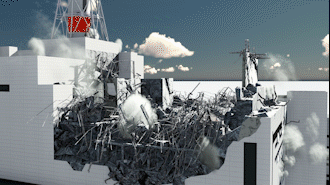Chernobyl disaster
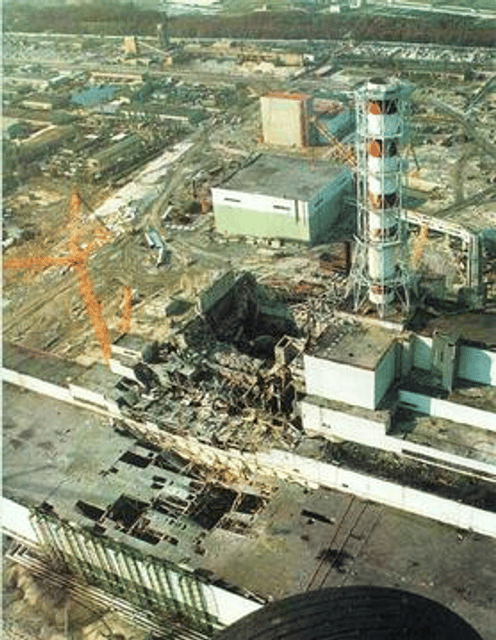
Chernobyl disaster

| Date | 26 April 1986 (1986-04-26) |
|---|---|
| Time | 01:23:40 MSD (UTC+04:00) |
| Location | Chernobyl nuclear power plant, Pripyat, Ukrainian Soviet Socialist Republic, Soviet Union |
| Type | Nuclear and radiation accident |
| Cause | Reactor design flaws and breach of protocol during simulated power outage safety test |
| Outcome | Chernobyl disaster effects |
| Deaths | less than 100, estimates on future projections, 4,000 (per United Nations; Chernobyl disaster-related deaths) |
The Chernobyl disaster was a nuclear accident that occurred on 26 April 1986 at the No. 4 nuclear reactor in the Chernobyl Nuclear Power Plant, near the city of Pripyat in the north of the Ukrainian Soviet Socialist Republic.[6][7] It is considered the worst nuclear disaster in history and is one of only two nuclear energy disasters rated at seven—the maximum severity—on the International Nuclear Event Scale, the other being the 2011 Fukushima Daiichi nuclear disaster in Japan.
The accident started during a safety test on an RBMK-type nuclear reactor, which was commonly used throughout the Soviet Union. The test was a simulation of an electrical power outage to aid the development of a safety procedure for maintaining cooling water circulation until the back-up generators could provide power. This operating gap was about one minute and had been identified as a potential safety problem that could cause the nuclear reactor core to overheat.
Three such tests had been conducted since 1982, but had failed to provide a solution. On this fourth attempt, the test was delayed by 10 hours, so the operating shift that had been prepared was not present. The test supervisor then failed to follow procedure, creating unstable operating conditions that, combined with inherent RBMK reactor design flaws and the intentional disabling of several nuclear reactor safety systems, resulted in an uncontrolled nuclear chain reaction.[8]
A large amount of energy was suddenly released, vapourising superheated cooling water and rupturing the reactor core in a highly destructive steam explosion. This was immediately followed by an open-air reactor core fire that released considerable airborne radioactive contamination for about nine days that precipitated onto parts of the USSR and western Europe, before being finally contained on 4 May 1986.[9][10]
The fire gradually released about the same amount of contamination as the initial explosion.[11] As a result of rising ambient radiation levels off-site, a 10-kilometre (6.2 mi) radius exclusion zone was created 36 hours after the accident. About 49,000 people were evacuated from the area, primarily from Pripyat. The exclusion zone was later increased to 30 kilometres (19 mi) radius when a further 68,000 people were evacuated from the wider area.[12][12]
To reduce the spread of radioactive contamination from the wreckage and to protect the site from further weathering, the remains of reactor No. 4 required a protective enclosure. The Chernobyl Nuclear Power Plant sarcophagus was built and finished by December 1986, and would also provide radiological protection for the crews of the undamaged reactors at the site, with No. 3 continuing to produce electricity until 2000.[13][14] Due to the continued deterioration of the sarcophagus, both it and the No. 4 reactor were further enclosed in 2017 by the Chernobyl New Safe Confinement, a larger enclosure that allows the removal of both the sarcophagus and the reactor debris, while containing the radioactive hazard. Nuclear clean-up is scheduled for completion in 2065.[15]
The reactor explosion killed two of the reactor operating staff. In the emergency response that followed, 134 firemen and station staff were hospitalized with acute radiation syndrome due to absorbing high doses of ionizing radiation. Of these 134 men, 28 died in the days to months afterward and approximately 14 suspected radiation-induced cancer deaths followed within the next 10 years.[16][17] Among the wider population, an excess of 15 childhood thyroid cancer deaths were documented as of 2011.[18][19] Due to the often long incubation periods for radiation exposure to induce cancer, the United Nations Scientific Committee on the Effects of Atomic Radiation (UNSCEAR) has, at multiple times, reviewed all the published research on the incident and found that at present, fewer than 100 documented deaths are likely to be attributable to increased exposure to radiation.[20]
Determining the total eventual number of exposure related deaths is based on the linear no-threshold model, a contested statistical model, which has also been used in estimates of low level radon and air pollution exposure.[21][22] Model predictions with the greatest confidence values of the eventual total death toll in the decades ahead from Chernobyl releases vary, from 4,000 fatalities when solely assessing the three most contaminated former Soviet states, to about 9,000 to 16,000 fatalities when assessing the total continent of Europe.[23]
The Chernobyl disaster is considered the worst nuclear power plant accident in history, both in terms of cost and casualties.[24] The struggle to safeguard against hazards immediately after the accident, together with later decontamination efforts of the surroundings, ultimately involved more than 500,000 liquidators and cost an estimated 18 billion Soviet rubles—roughly US$68 billion in 2019, adjusted for inflation.[11][25] The accident prompted safety upgrades on all remaining Soviet-designed RBMK reactors, of which 10 continue to be operational as of 2019.[26][27]
| Date | 26 April 1986 (1986-04-26) |
|---|---|
| Time | 01:23:40 MSD (UTC+04:00) |
| Location | Chernobyl nuclear power plant, Pripyat, Ukrainian Soviet Socialist Republic, Soviet Union |
| Type | Nuclear and radiation accident |
| Cause | Reactor design flaws and breach of protocol during simulated power outage safety test |
| Outcome | Chernobyl disaster effects |
| Deaths | less than 100, estimates on future projections, 4,000 (per United Nations; Chernobyl disaster-related deaths) |
Background

Reactor decay heat shown as % of thermal power from time of sustained fission shutdown using two different correlations. Due to decay heat, solid fuel power reactors need high flows of coolant after a fission shutdown for a considerable time to prevent fuel cladding damage, or in the worst case, a full core meltdown.
In steady-state operation, a significant fraction (over 6%) of the power from a nuclear reactor is derived not from fission but from the decay heat of its accumulated fission products. This heating continues for some time after the chain reaction has been stopped (e.g. following an emergency scram) and active cooling is required to prevent core meltdown.[28] RBMK reactors like those at Chernobyl use water as a coolant.[29][30] Reactor No. 4 at Chernobyl included about 1,600 individual fuel channels, each of which required coolant flow of 28 metric tons (28,000 litres or 7,400 US gallons) per hour.[31]
Since cooling pumps still require electricity and must run for some time after an emergency shutdown in the event of a power grid failure, each of Chernobyl's reactors had three backup diesel generators. The backup generators could start up in 15 seconds, but took 60–75 seconds to attain full speed[31] [] and generate the 5.5‑megawatt output required to run one main pump.[31] []
This one-minute delay constituted a significant safety risk. It had been theorized that the stored rotational inertia of the steam turbines and the residual steam pressure could be used to generate the required electrical power to cover this gap. Analysis indicated that this might be sufficient to provide electrical power to run the coolant pumps for 45 seconds,[31] [] not quite bridging the gap between an external power failure and the full availability of the emergency generators.[32]
This capability still needed to be confirmed experimentally, and previous tests had ended unsuccessfully. An initial test carried out in 1982 indicated that the excitation voltage of the turbine-generator was insufficient; it did not maintain the desired magnetic field after the turbine trip. The system was modified, and the test was repeated in 1984 but again proved unsuccessful. In 1985, a test was conducted a third time but also yielded negative results. The test procedure was to be run again in 1986, and scheduled to take place during a maintenance shutdown of reactor No. 4.[32]
Test plan
The test focused on the switching sequences of the electrical supplies for the reactor. The test procedure was expected to begin with an automatic emergency shutdown. No detrimental effect on the safety of the reactor was anticipated, so the test programme was not formally coordinated with either the chief designer of the reactor (NIKIET) or the scientific manager. Instead, it was approved only by the director of the plant (and even this approval was not consistent with established procedures).[33]
According to the test parameters, the thermal output of the reactor should have been no lower than 700 MW at the start of the experiment. If test conditions had been maintained as prescribed, the procedure would almost certainly have been carried out safely; the eventual disaster resulted from attempts to boost the reactor output once the experiment had been started and an operational misstep had let the output fall too low, inconsistent with approved procedure.[33]
The Chernobyl power plant had been in operation for two years without the capability to ride through the first 60–75 seconds of a total loss of electric power, and thus lacked an important safety feature. The station managers presumably wished to correct this at the first opportunity, which may explain why they continued the test even when serious problems arose, and why the requisite approval for the test had not been sought from the Soviet nuclear oversight regulator (even though there was a representative at the complex of four reactors).[1]
The experimental procedure was intended to run as follows:
The reactor was to be running at a low power level, between 700 MW and 800 MW
The steam-turbine generator was to be run up to full speed
When these conditions were achieved, the steam supply for the turbine generator was to be closed off
Turbine generator performance was to be recorded to determine whether it could provide the bridging power for coolant pumps until the emergency diesel generators were sequenced to start and provide power to the cooling pumps automatically
After the emergency generators reached normal operating speed and voltage, the turbine generator would be allowed to continue to freewheel down
Operating conditions

Process flow diagram of the reactor

Comparative Generation II reactor vessels size comparison, a design classification of commercial reactors built until the end of the 1990s.
The test was to be conducted during the day-shift of 25 April 1986 as part of a scheduled reactor shut down. The day shift crew had been instructed in advance on the reactor operating conditions to run the test and in addition, a special team of electrical engineers was present to conduct the one-minute test of the new voltage regulating system once the correct conditions had been reached.[34] As planned, a gradual reduction in the output of the power unit began at 01:06 on 25 April, and the power level had reached 50% of its nominal 3,200 MW thermal level by the beginning of the day shift.
At this point, another regional power station unexpectedly went offline, and the Kiev electrical grid controller requested that the further reduction of Chernobyl's output be postponed, as power was needed to satisfy the peak evening demand. The Chernobyl plant director agreed, and postponed the test. Despite this delay, preparations for the test not affecting the reactor's power were carried out, including the disabling of the emergency core cooling system or ECCS, a passive/active system of core cooling intended to provide water to the core in a loss-of-coolant accident. Given the other events that unfolded, the system would have been of limited use, but its disabling as a "routine" step of the test is indicative of the lack of attention to safety in the test.[35] In addition, had the reactor been shut down for the day as planned, it is possible that more preparation would have been taken in advance of the test.
At 23:04, the Kiev grid controller allowed the reactor shutdown to resume. This delay had some serious consequences: the day shift had long since departed, the evening shift was also preparing to leave, and the night shift would not take over until midnight, well into the job. According to plan, the test should have been finished during the day shift, and the night shift would only have had to maintain decay heat cooling systems in an otherwise shut-down plant.[31] []
The night shift had very limited time to prepare for and carry out the experiment. A further rapid decrease in the power level from 50% was executed during the shift change-over. Anatoly Dyatlov, deputy chief-engineer of the entire Chernobyl Nuclear Power Plant, was present to supervise and direct the experiment; as he out-ranked all other supervisory personnel present, his orders and instructions overrode any objections of other senior personnel present during the test and its preparation. (In 1987, Dyatlov would be found guilty "of criminal mismanagement of potentially explosive enterprises" and sentenced to 10 years imprisonment—of which he would serve three[36]—for the role that his oversight of the experiment played in the ensuing accident.) Serving under Dyatlov, Aleksandr Akimov was chief of the night shift, and Leonid Toptunov was the operator responsible for the reactor's operational regimen, including the movement of the control rods. Toptunov was a young engineer who had worked independently as a senior engineer for approximately three months.[31] []
The test plan called for a gradual decrease in power output from reactor No. 4 to a thermal level of 700–1000 MW.[37] An output of 700 MW was reached at 00:05 on 26 April. Due to the reactor's production of a fission byproduct, xenon-135, which is a reaction-inhibiting neutron absorber, core power continued to decrease in the absence of further operator action—a process known as reactor poisoning. In steady-state operation, this is avoided because xenon-135 is "burned off" as quickly as it is created from decaying iodine-135 by the absorption of neutrons from the ongoing chain reaction, becoming highly stable xenon-136. With the reactor power reduced, previously produced high quantities of iodine-135 were decaying into the neutron-absorbing xenon-135 faster than the now reduced neutron flux could burn off. As the reactor power output dropped further, to approximately 500 MW, the power suddenly fell into an unintended near-shutdown state, with a power output of 30 MW thermal or less. The exact circumstances that caused the power fall are unknown because Akimov died in hospital on 10 May and Toptunov on 14 May; early reports attributed it to Toptunov mistakenly inserting the control rods too far into the core, but it has also been suggested it was due to an equipment failure.[33] []
The reactor was now producing 5% of the minimum initial power level prescribed for the test.[33] [] Control-room personnel decided to raise power by disconnecting most of the reactor control rods from the automatic control rod regulation system and manually extracting the majority of rods to their upper limits.[38] Several minutes elapsed between their extraction and the point at which the power output began to increase and subsequently stabilize at 160–200 MW (thermal), a much lower level than the prescribed 700 MW. The rapid reduction in the power during the initial shutdown, and the subsequent operation at a level of less than 200 MW led to increased poisoning of the reactor core by the accumulation of xenon-135.[2] This prevented the rise of reactor power, and made it necessary to extract additional control rods from the reactor core in order to counteract the poisoning.
The operation of the reactor at the low power level (and high poisoning level) was accompanied by unstable core temperatures and coolant flow, and possibly by instability of neutron flux, which triggered alarms. The control room received repeated emergency signals regarding the levels in the steam/water separator drums, and large excursions or variations in the flow rate of feed water, as well as from relief valves opened to relieve excess steam into a turbine condenser, and from the neutron power controller. Between 00:35 and 00:45, emergency alarm signals concerning thermal-hydraulic parameters were ignored, apparently to preserve the reactor power level.[40]
When a power level of 200 MW was reattained, preparation for the experiment continued. As part of the test plan, extra water pumps were activated at 01:05, increasing the water flow. The increased coolant flow rate through the reactor produced an increase in the inlet coolant temperature of the reactor core (the coolant no longer having sufficient time to release its heat in the turbine and cooling towers), which now more closely approached the nucleate boiling temperature of water, reducing the safety margin.
The flow exceeded the allowed limit at 01:19, triggering an alarm of low steam pressure in the steam separators. At the same time, the extra water flow lowered the overall core temperature and reduced the existing steam voids in the core and the steam separators.[3] Since water weakly absorbs neutrons (and the higher density of liquid water makes it a better absorber than steam), the activation of the additional pumps decreased the reactor power. The crew responded by turning off two of the circulation pumps to reduce feedwater flow, in an effort to increase steam pressure, and by removing more manual control rods to maintain power.[35][41]
The combined effect of these various actions was an extremely unstable reactor configuration. Nearly all of the 211 control rods had been extracted manually, including all but 18 of the "fail-safe" manually operated rods of the minimum 28 that were supposed to remain fully inserted to control the reactor even in the event of a loss of coolant.[42][43] While the emergency scram system that would insert all control rods to shut down the reactor could still be activated manually (through the "AZ-5" switch), the automated system that would ordinarily do the same had been mostly disabled to maintain the power level, and many other automated and even passive safety features of the reactor had been bypassed. The reduction of reactor coolant pumping left little safety margin; any power excursion could produce boiling, thereby reducing neutron absorption by the water. The reactor configuration was outside the safe operating envelope prescribed by the designers. If anything pushed it into supercriticality, it would be unable to recover automatically.
Accident

Plan view of reactor No. 4 core. Numbers show insertion depths of control rods in centimeters at the moment of the explosion. startup neutron sources (12) control rods (167) short control rods from below reactor (32) automatic control rods (12) pressure tubes with fuel rods (1661)
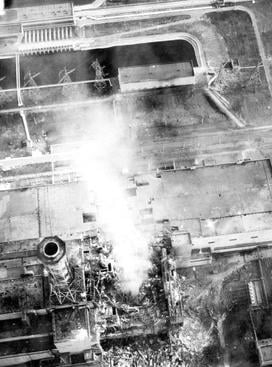
Steam plumes continued to be generated days after the initial explosion[48]
At 01:23:04, the test began.[44] Four of the main circulating pumps (MCP) were active (of the eight total, six are normally active under regular operation). The steam to the turbines was shut off, beginning a run-down of the turbine generator. The diesel generators started and sequentially picked up loads; the generators were to have completely picked up the MCPs' power needs by 01:23:43. In the interim, the power for the MCPs was to be supplied by the turbine generator as it coasted down. As the momentum of the turbine generator decreased, so did the power it produced for the pumps. The water flow rate decreased, leading to increased formation of steam voids in the coolant flowing up through the fuel pressure tubes.
Unlike western light-water reactors, the RBMK has a positive void coefficient of reactivity at low power levels, meaning that when cooling water boils excessively in the fuel pressure tubes it produces large steam voids in the coolant rather than small bubbles. This intensifies the nuclear chain reaction, as it reduces the relative volume of cooling water available to absorb neutrons. The consequent power increase then produces more voids which further intensifies the chain reaction, and so on. Given this characteristic, reactor No. 4 was now at risk of a runaway increase in its core power with nothing to restrain it.
Throughout most of the experiment the local automatic control system (LAC) successfully counteracted this positive feedback, by inserting control rods into the reactor core to limit the power rise. However, this system had control of only 12 rods, as nearly all the others had been manually retracted by the reactor operators.
At 01:23:40, as recorded by the SKALA centralized control system, a Scram (emergency shutdown) of the reactor was initiated.[45] The SCRAM was started when the AZ-5 button (also known as the EPS-5 button) of the reactor emergency protection system was pressed: this engaged the drive mechanism on all control rods to fully insert them, including the manual control rods that had been withdrawn earlier. The reason why the button was pressed is not known, whether it was done as an emergency measure in response to rising temperatures, or simply as a routine method of shutting down the reactor upon completion of the experiment.
One view is that the scram may have been ordered as a response to the unexpected rapid power increase, although there is no recorded data showing this. Some have suggested that the button was not manually pressed, and that the scram signal was automatically produced by the emergency protection system, but the SKALA registered a manual scram signal. Despite this, the question as to when or even whether the AZ-5 button was pressed has been the subject of debate. There have been assertions that the manual scram was initiated due to the initial rapid power acceleration. Others have suggested that the button was not pressed until the reactor began to self-destruct, while others believe that it happened earlier and under calm conditions.[46] [] [47]
When the AZ-5 button was pressed, the insertion of control rods into the reactor core began. The control rod insertion mechanism moved the rods at 0.4 metres per second (1.3 ft/s), so that the rods took 18 to 20 seconds to travel the full height of the core, about 7 metres (23 ft). A bigger problem was the design of the RBMK control rods, each of which had a graphite neutron moderator section attached to its end to boost reactor output by displacing water when the control rod section had been fully withdrawn from the reactor, i.e. when a control rod was at maximum extraction, a neutron-moderating graphite extension was centered in the core with 1.25 metres (4.1 ft) columns of water above and below it.
Consequently, injecting a control rod downward into the reactor in a scram initially displaced (neutron-absorbing) water in the lower portion of the reactor with (neutron-moderating) graphite. Thus, an emergency scram initially increased the reaction rate in the lower part of the core.[33] [] This behaviour had been discovered when the initial insertion of control rods in another RBMK reactor at Ignalina Nuclear Power Plant in 1983 induced a power spike. Procedural countermeasures were not implemented in response to Ignalina; INSAG-7 later stated, "Apparently, there was a widespread view that the conditions under which the positive scram effect would be important would never occur. However, they did appear in almost every detail in the course of the actions leading to the (Chernobyl) accident."[33] []
A few seconds into the scram, a power spike did occur and the core overheated, causing some of the fuel rods to fracture, blocking the control rod columns and jamming the control rods at one-third insertion, with the graphite water-displacers still in the lower part of the core. Within three seconds the reactor output rose above 530 MW.[31] []
The subsequent course of events was not registered by instruments; it has been reconstructed through mathematical simulation. Per the simulation, the power spike would have caused an increase in fuel temperature and steam buildup, leading to a rapid increase in steam pressure. This caused the fuel cladding to fail, releasing the fuel elements into the coolant, and rupturing the channels in which these elements were located.[49]
Explosions
As the scram was starting, the reactor output jumped to around 30,000 MW thermal, 10 times its normal operational output, the indicated last reading on the power meter on the control panel. Some estimate the power spike may have gone 10 times higher than that. It was not possible to reconstruct the precise sequence of the processes that led to the destruction of the reactor and the power unit building, but a steam explosion, like the explosion of a steam boiler from excess vapour pressure, appears to have been the next event. There is a general understanding that it was explosive steam pressure from the damaged fuel channels escaping into the reactor's exterior cooling structure that caused the explosion that destroyed the reactor casing, tearing off and blasting the upper plate called the upper biological shield,[50] to which the entire reactor assembly is fastened, through the roof of the reactor building. This is believed to be the first explosion that many heard.[52] []
This explosion ruptured further fuel channels, as well as severing most of the coolant lines feeding the reactor chamber, and as a result, the remaining coolant flashed to steam and escaped the reactor core. The total water loss in combination with a high positive void coefficient further increased the reactor's thermal power.
A second, more powerful explosion occurred about two or three seconds after the first; this explosion dispersed the damaged core and effectively terminated the nuclear chain reaction. This explosion also compromised more of the reactor containment vessel and ejected hot lumps of graphite moderator. The ejected graphite and the demolished channels still in the remains of the reactor vessel caught fire on exposure to air, greatly contributing to the spread of radioactive fallout and the contamination of outlying areas.[35][4]
According to observers outside Unit 4, burning lumps of material and sparks shot into the air above the reactor. Some of them fell onto the roof of the machine hall and started a fire. About 25% of the red-hot graphite blocks and overheated material from the fuel channels was ejected. Parts of the graphite blocks and fuel channels were out of the reactor building. As a result of the damage to the building an airflow through the core was established by the high temperature of the core. The air ignited the hot graphite and started a graphite fire.[31] []
After the larger explosion, a number of employees at the power station went outside to get a clearer view of the extent of the damage. One such survivor, Alexander Yuvchenko, recounts that once he stepped outside and looked up towards the reactor hall, he saw a "very beautiful" laser-like beam of blue light caused by the ionized-air glow that appeared to "flood up into infinity".[55][56][57]
There were initially several hypotheses about the nature of the second explosion. One view was that the second explosion was caused by the combustion of hydrogen, which had been produced either by the overheated steam-zirconium reaction or by the reaction of red-hot graphite with steam that produced hydrogen and carbon monoxide. Another hypothesis, by Checherov, published in 1998, was that the second explosion was a thermal explosion of the reactor as a result of the uncontrollable escape of fast neutrons caused by the complete water loss in the reactor core.[58] A third hypothesis was that the second explosion was another steam explosion. According to this version, the first explosion was a more minor steam explosion in the circulating loop, causing a loss of coolant flow and pressure that in turn caused the water still in the core to flash to steam; this second explosion then caused the majority of the damage to the reactor and containment building.
Other explosion hypotheses
The force of the second explosion and the ratio of xenon radioisotopes released after the accident (a vital tool in nuclear forensics) indicated to Yuri V. Dubasov in a 2009 publication (suggested before him by Checherov in 1998), that the second explosion could have been a nuclear power transient resulting from core material melting in the absence of its water coolant and moderator. Dubasov argues that the reactor did not simply undergo a runaway delayed-supercritical exponential increase in power into the multi-gigawatt power range. That permitted a dangerous "positive feedback" runaway condition, given the lack of passive nuclear safety stops, such as Doppler broadening, when power levels began to increase above the commercial level.[59]
The evidence for this hypothesis originates at Cherepovets, Vologda Oblast, Russia, 1000 km northeast of Chernobyl. Physicists from the V.G. Khlopin Radium Institute in Leningrad measured anomalous xenon-135 — a short half-life isotope — levels at Cherepovets four days after the explosion, even as the general distribution was spreading the radiation to the north in Scandinavia. It is thought that a nuclear event in the reactor may have raised xenon to higher levels in the atmosphere than the later fire did, which moved the xenon to that location.[60]
That while this positive-feedback power excursion that increased until the reactor disassembled itself by means of its internal energy and external steam explosions[33] is the more accepted explanation for the cause of the explosions, Dubasov argues instead that a runaway prompt criticality occurred, with the internal physics being more similar to the explosion of a fizzled nuclear weapon, and that this failed/fizzle event produced the second explosion.[59]
This nuclear fizzle hypothesis, then mostly defended by Dubasov, was examined further in 2017 by retired physicist Lars-Erik De Geer in an analysis that puts the hypothesized fizzle event as the more probable cause of the first explosion.[61][62][63] The more energetic second explosion, which produced the majority of the damage, has been estimated by Dubasov in 2009 as equivalent to 40 billion joules of energy, the equivalent of about 10 tons of TNT. Both the 2009 and 2017 analyses argue that the nuclear fizzle event, whether producing the second or first explosion, consisted of a prompt chain reaction (as opposed to the consensus delayed neutron mediated chain-reaction) that was limited to a small portion of the reactor core, since expected self-disassembly occurs rapidly in fizzle events.[59][61][64]
Lars-Eric De Geer comments:
"We believe that thermal neutron mediated nuclear explosions at the bottom of a number of fuel channels in the reactor caused a jet of debris to shoot upwards through the refuelling tubes. This jet then rammed the tubes' 350kg plugs, continued through the roof and travelled into the atmosphere to altitudes of 2.5-3km where the weather conditions provided a route to Cherepovets. The steam explosion which ruptured the reactor vessel occurred some 2.7 seconds later."[60]
Crisis management
Fire containment
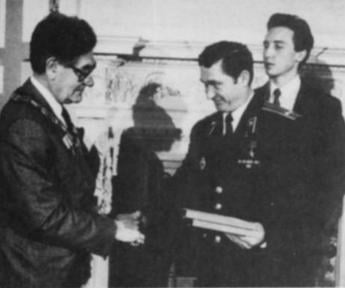
Firefighter Leonid Telyatnikov being decorated for bravery
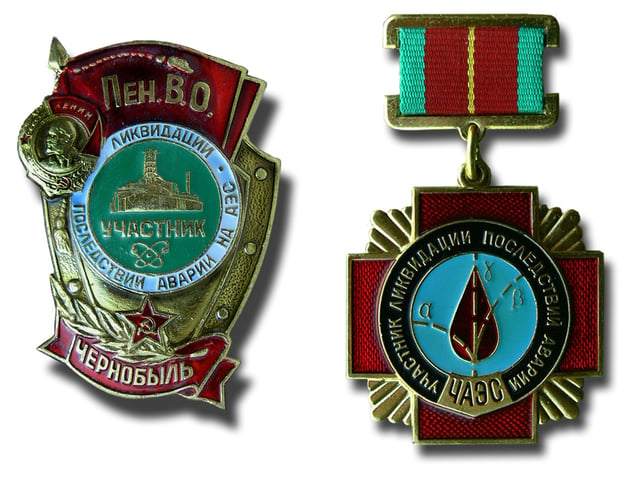
Soviet badge awarded to Chernobyl liquidator
Contrary to safety regulations, bitumen, a combustible material, had been used in the construction of the roof of the reactor building and the turbine hall. Ejected material ignited at least five fires on the roof of the adjacent reactor No. 3, which was still operating. It was imperative to put those fires out and protect the cooling systems of reactor No. 3.[31] [] Inside reactor No. 3, the chief of the night shift, Yuri Bagdasarov, wanted to shut down the reactor immediately, but chief engineer Nikolai Fomin would not allow this. The operators were given respirators and potassium iodide tablets and told to continue working. At 05:00, Bagdasarov made his own decision to shut down the reactor, leaving only those operators there who had to work the emergency cooling systems.[31] []
Shortly after the accident, at 01:45, firefighters arrived to try to extinguish the fires.[44] First on the scene was a Chernobyl Power Station firefighter brigade under the command of Lieutenant Volodymyr Pravik, who died on 9 May 1986 of acute radiation sickness. They were not told how dangerously radioactive the smoke and the debris were, and may not even have known that the accident was anything more than a regular electrical fire: "We didn't know it was the reactor. No one had told us."[65] Grigorii Khmel, the driver of one of the fire engines, later described what happened:
We arrived there at 10 or 15 minutes to two in the morning ... We saw graphite scattered about. Misha asked: "Is that graphite?" I kicked it away. But one of the fighters on the other truck picked it up. "It's hot," he said. The pieces of graphite were of different sizes, some big, some small, enough to pick them up [...] We didn't know much about radiation. Even those who worked there had no idea. There was no water left in the trucks. Misha filled a cistern and we aimed the water at the top. Then those boys who died went up to the roof—Vashchik, Kolya and others, and Volodya Pravik ... They went up the ladder ... and I never saw them again.[66]
Anatoli Zakharov, a fireman stationed in Chernobyl since 1980, offers a different description in 2008: "I remember joking to the others, 'There must be an incredible amount of radiation here. We'll be lucky if we're all still alive in the morning.'"[67] He also stated: "Of course we knew! If we'd followed regulations, we would never have gone near the reactor. But it was a moral obligation—our duty. We were like kamikaze."[67]
The immediate priority was to extinguish fires on the roof of the station and the area around the building containing Reactor No. 4 to protect No. 3 and keep its core cooling systems intact. The fires were extinguished by 5:00, but many firefighters received high doses of radiation. The fire inside reactor No. 4 continued to burn until 10 May 1986; it is possible that well over half of the graphite burned out.[31] []
It was thought by some that the core fire was extinguished by a combined effort of helicopters dropping more than 5000 metric tons of sand, lead, clay, and neutron-absorbing boron onto the burning reactor. It is now known that virtually none of the neutron absorbers reached the core.[68] Historians estimate that about 600 Soviet pilots risked dangerous levels of radiation to fly the thousands of flights needed to cover reactor No. 4 in this attempt to seal off radiation.[69]
From eyewitness accounts of the firefighters involved before they died (as reported on the CBC television series Witness), one described his experience of the radiation as "tasting like metal", and feeling a sensation similar to that of pins and needles all over his face. (This is similar to the description given by Louis Slotin, a Manhattan Project physicist who died days after a fatal radiation overdose from a criticality accident.)[70]
The explosion and fire threw hot particles of the nuclear fuel and also far more dangerous fission products, radioactive isotopes such as caesium-137, iodine-131, strontium-90, and other radionuclides, into the air: the residents of the surrounding area observed the radioactive cloud on the night of the explosion.
Equipment assembled included remote-controlled bulldozers and robot-carts that could detect radioactivity and carry hot debris. Valery Legasov, first deputy director of the Kurchatov Institute of Atomic Energy in Moscow, said in 1987: "But we learned that robots are not the great remedy for everything. Where there was very high radiation, the robot ceased to be a robot—the electronics quit working."[71]
Radiation levels
The ionizing radiation levels in the worst-hit areas of the reactor building have been estimated to be 5.6 roentgens per second (R/s), equivalent to more than 20,000 roentgens per hour. A lethal dose is around 500 roentgens (~5 Gray (Gy) in modern radiation units) over five hours, so in some areas, unprotected workers received fatal doses in less than a minute. However, a dosimeter capable of measuring up to 1,000 R/s was buried in the rubble of a collapsed part of the building, and another one failed when turned on. All remaining dosimeters had limits of 0.001 R/s and therefore read "off scale". Thus, the reactor crew could ascertain only that the radiation levels were somewhere above 0.001 R/s (3.6 R/h), while the true levels were much higher in some areas.[31] []
Because of the inaccurate low readings, the reactor crew chief Aleksandr Akimov assumed that the reactor was intact. The evidence of pieces of graphite and reactor fuel lying around the building was ignored, and the readings of another dosimeter brought in by 04:30 were dismissed under the assumption that the new dosimeter must have been defective.[31] [] Akimov stayed with his crew in the reactor building until morning, sending members of his crew to try to pump water into the reactor. None of them wore any protective gear. Most, including Akimov, died from radiation exposure within three weeks.[42][43] []
Evacuation

Pripyat with the Chernobyl Nuclear Power Plant in the distance
The nearby city of Pripyat was not immediately evacuated. The townspeople, in the early hours of the morning, at 01:23 local time, went about their usual business, completely oblivious to what had just happened. However, within a few hours of the explosion, dozens of people fell ill. Later, they reported severe headaches and metallic tastes in their mouths, along with uncontrollable fits of coughing and vomiting.[72] As the plant was run by authorities in Moscow, the government of Ukraine did not receive prompt information on the accident.[73]
Valentyna Shevchenko, then Chairwoman of the Presidium of Verkhovna Rada Supreme Soviet of the Ukrainian SSR, recalls that Ukraine's acting Minister of Internal Affairs Vasyl Durdynets phoned her at work at 09:00 to report current affairs; only at the end of the conversation did he add that there had been a fire at the Chernobyl nuclear power plant, but it was extinguished and everything was fine. When Shevchenko asked "How are the people?", he replied that there was nothing to be concerned about: "Some are celebrating a wedding, others are gardening, and others are fishing in the Pripyat River".[73]
Shevchenko then spoke over the phone to Volodymyr Shcherbytsky, head of the Central Committee of the Communist Party of Ukraine and de facto head of state, who said he anticipated a delegation of the state commission headed by Boris Shcherbina, the deputy chairman of the Council of Ministers of the USSR.[73]
A commission was established later in the day to investigate the accident. It was headed by Valery Legasov, First Deputy Director of the Kurchatov Institute of Atomic Energy, and included leading nuclear specialist Evgeny Velikhov, hydro-meteorologist Yuri Izrael, radiologist Leonid Ilyin, and others. They flew to Boryspil International Airport and arrived at the power plant in the evening of 26 April.[73] By that time two people had already died and 52 were hospitalized. The delegation soon had ample evidence that the reactor was destroyed and extremely high levels of radiation had caused a number of cases of radiation exposure. In the early daylight hours of 27 April, approximately 36 hours after the initial blast, they ordered the evacuation of Pripyat. Initially it was decided to evacuate the population for three days; later this was made permanent.[73]
By 11:00 on 27 April, buses had arrived in Pripyat to start the evacuation.[73] The evacuation began at 14:00. A translated excerpt of the evacuation announcement follows:
For the attention of the residents of Pripyat! The City Council informs you that due to the accident at Chernobyl Power Station in the city of Pripyat the radioactive conditions in the vicinity are deteriorating. The Communist Party, its officials and the armed forces are taking necessary steps to combat this. Nevertheless, with the view to keep people as safe and healthy as possible, the children being top priority, we need to temporarily evacuate the citizens in the nearest towns of Kiev region. For these reasons, starting from 27 April 1986, 14:00 each apartment block will be able to have a bus at its disposal, supervised by the police and the city officials. It is highly advisable to take your documents, some vital personal belongings and a certain amount of food, just in case, with you. The senior executives of public and industrial facilities of the city has decided on the list of employees needed to stay in Pripyat to maintain these facilities in a good working order. All the houses will be guarded by the police during the evacuation period. Comrades, leaving your residences temporarily please make sure you have turned off the lights, electrical equipment and water and shut the windows. Please keep calm and orderly in the process of this short-term evacuation.[74]
To expedite the evacuation, residents were told to bring only what was necessary, and that they would remain evacuated for approximately three days. As a result, most personal belongings were left behind, and remain there today. By 15:00, 53,000 people were evacuated to various villages of the Kiev region.[73] The next day, talks began for evacuating people from the 10-kilometre (6.2 mi) zone.[73] 10 days after the accident, the evacuation area was expanded to 30 kilometres (19 mi).[75] [] The Chernobyl Nuclear Power Plant Exclusion Zone has remained ever since, although its shape has changed and its size has been expanded.
The surveying and detection of isolated fallout hotspots outside this zone over the following year eventually resulted in 135,000 long-term evacuees in total agreeing to be moved.[12] The years between 1986 and 2000 saw the near tripling in the total number of permanently resettled persons from the most severely contaminated areas to approximately 350,000.[76][77]
Delayed announcement
Evacuation began long before the accident was publicly acknowledged by the Soviet Union. In the morning of 28 April, radiation levels set off alarms at the Forsmark Nuclear Power Plant in Sweden,[78][79] over 1,000 kilometres (620 mi) from the Chernobyl Plant. Workers at Forsmark reported the case to the Swedish Radiation Safety Authority, which determined that the radiation had originated elsewhere.[79] That day, the Swedish government contacted the Soviet government to inquire about whether there had been a nuclear accident in the Soviet Union.[79] The Soviets initially denied it, and it was only after the Swedish government suggested they were about to file an official alert with the International Atomic Energy Agency, that the Soviet government admitted an accident took place at Chernobyl.[79]
At first, the Soviets only conceded that a minor accident had occurred, but once they began evacuating more than 100,000 people, the full scale of the situation was realized by the global community.[80] At 21:02 the evening of 28 April, a 20-second announcement was read in the TV news programme Vremya: "There has been an accident at the Chernobyl Nuclear Power Plant. One of the nuclear reactors was damaged. The effects of the accident are being remedied. Assistance has been provided for any affected people. An investigative commission has been set up."[13][81][81] This was the entirety of the announcement of the accident. The Telegraph Agency of the Soviet Union (TASS) then discussed the Three Mile Island accident and other American nuclear accidents, an example of the common Soviet tactic of whataboutism when one occurred in the Soviet Union. The mention of a commission, however, indicated to observers the seriousness of the incident,[82] and subsequent state radio broadcasts were replaced with classical music, which was a common method of preparing the public for an announcement of a tragedy.[13]
Around the same time, ABC News released its report about the disaster.[83] Shevchenko was the first of the Ukrainian state top officials to arrive at the disaster site early on 28 April. There she spoke with members of medical staff and people, who were calm and hopeful that they could soon return to their homes. Shevchenko returned home near midnight, stopping at a radiological checkpoint in Vilcha, one of the first that were set up soon after the accident.[73]
There was a notification from Moscow that there was no reason to postpone the 1 May International Workers' Day celebrations in Kiev (including the annual parade), but on 30 April a meeting of the Political bureau of the Central Committee of the CPSU took place to discuss the plan for the upcoming celebration. Scientists were reporting that the radiological background level in Kiev was normal. At the meeting, which was finished at 18:00, it was decided to shorten celebrations from the regular three and a half to four hours to under two hours.[73] Several buildings in Pripyat were officially kept open after the disaster to be used by workers still involved with the plant. These included the Jupiter factory which closed in 1996 and the Azure Swimming Pool, used by the Chernobyl liquidators for recreation during the clean-up, which closed in 1998.
Explosion risk
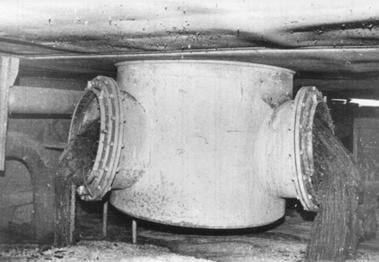
Chernobyl corium lava, formed by fuel-containing mass, flowed into the basement of the plant.[84]

Extremely high levels of radioactivity in the lava under the Chernobyl number four reactor in 1986
Two floors of bubbler pools beneath the reactor served as a large water reservoir for the emergency cooling pumps and as a pressure suppression system capable of condensing steam in case of a small broken steam pipe; the third floor above them, below the reactor, served as a steam tunnel. The steam released by a broken pipe was supposed to enter the steam tunnel and be led into the pools to bubble through a layer of water. After the disaster, the pools and the basement were flooded because of ruptured cooling water pipes and accumulated firefighting water, and constituted a serious steam explosion risk.
The smoldering graphite, fuel and other material above, at more than 1,200 °C (2,190 °F),[85] started to burn through the reactor floor and mixed with molten concrete from the reactor lining, creating corium, a radioactive semi-liquid material comparable to lava.[84][86] If this mixture had melted through the floor into the pool of water, it was feared it could have created a serious steam explosion that would have ejected more radioactive material from the reactor. It became necessary to drain the pool.[87]
The bubbler pool could be drained by opening its sluice gates. However, the valves controlling it were underwater, located in a flooded corridor in the basement. Volunteers in wetsuits and respirators (for protection against radioactive aerosols) and equipped with dosimeters, entered the knee-deep radioactive water and managed to open the valves.[88][89] These were the engineers Alexei Ananenko and Valeri Bezpalov (who knew where the valves were), accompanied by the shift supervisor Boris Baranov.[90][91][92] Upon succeeding, all risk of a further steam explosion was eliminated. All three men were awarded the Order For Courage by Ukrainian President Petro Poroshenko in May 2018.[93]
Research by Andrew Leatherbarrow, author of Chernobyl 01:23:40,[88] determined that the frequently recounted story that suggests that all three men died just days after the incident is false. Alexei Ananenko continues to work in the nuclear energy industry, and rebuffs the growth of the Chernobyl media sensationalism surrounding him.[94] While Valeri Bezpalov was found to still be alive by Leatherbarrow, the 65-year-old Baranov had lived until 2005 and had died of heart failure.[95] Once the bubbler pool gates were opened by the Ananenko team, fire brigade pumps were then used to drain the basement. The operation was not completed until 8 May, after 20,000 metric tons (20,000 long tons; 22,000 short tons) of water were pumped out.
With the bubbler pool gone, a meltdown was less likely to produce a powerful steam explosion. To do so, the molten core would now have to reach the water table below the reactor. To reduce the likelihood of this, it was decided to freeze the earth beneath the reactor, which would also stabilize the foundations. Using oil well drilling equipment, the injection of liquid nitrogen began on 4 May. It was estimated that 25 metric tons of liquid nitrogen per day would be required to keep the soil frozen at −100 °C (−148 °F).[31] [] This idea was soon scrapped.[96]
As an alternative, coal miners were deployed to excavate a tunnel below the reactor to make room for a cooling system. The final makeshift design for the cooling system was to incorporate a coiled formation of pipes cooled with water and covered on top with a thin thermally conductive graphite layer. The graphite layer as a natural refractory material would rapidly cool the suspected molten uranium oxide without burn through. This graphite cooling plate layer was to be encapsulated between two concrete layers, each one meter thick for stabilisation. This system was designed by Bolshov, the director of the Institute for Nuclear Safety and Development formed in 1988. Bolshov's graphite-concrete "sandwich" would be similar in concept to later core catchers that are now part of many nuclear reactor designs.[97]
Bolshov's graphite cooling plate, alongside the prior nitrogen injection proposal, were not used following the drop in aerial temperatures and indicative reports that the fuel melt had stopped. It was later determined that the fuel had passed through three storeys before coming to rest in one of a number of basement rooms. The precautionary underground channel with its active cooling was therefore deemed redundant, as the fuel was self-cooling. The excavation was then simply filled with concrete to strengthen the foundation below the reactor.[98]
It is likely that intense alpha radiation hydrolysed the water, generating a low-pH hydrogen peroxide (H2O2) solution akin to an oxidizing acid.[99] Conversion of water from an unknown source, to H2O2 is confirmed by the presence in the Chernobyl lavas of studtite and metastudtite,[100][101] the only minerals that contain peroxide.[102]
Debris removal
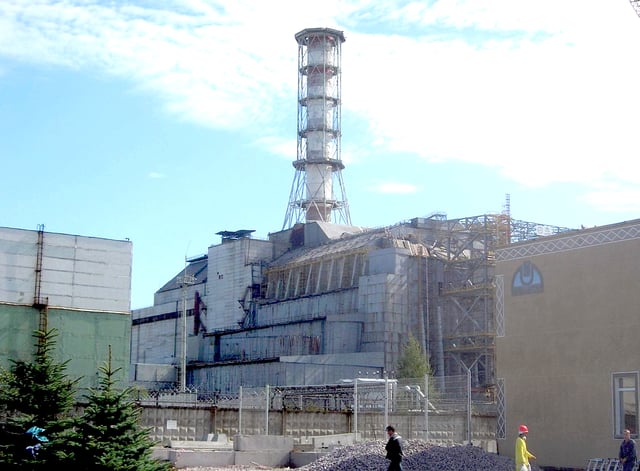
Chernobyl power plant in 2006 with the sarcophagus containment structure
In the months after the explosion, attention turned to removing the radioactive debris from the roof.[103] The worst of the radioactive debris was collected inside what was left of the reactor, however it was estimated that there was approximately 100 tons of debris on that roof that resulted from the explosion and which had to be removed to enable the safe construction of the 'sarcophagus' – a concrete structure that would entomb the reactor and reduce radioactive dust being released into the atmosphere.[103] The initial plan was to use robots to clear the debris off the roof. The Soviets used approximately 60 remote-controlled robots, most of them built in the Soviet Union although many failed due to the effect of high levels of radiation on their electronic controls.[103]
Consequently, the most highly radioactive materials were shoveled by Chernobyl liquidators from the military wearing heavy protective gear (dubbed "bio-robots" by the military); these soldiers could only spend a maximum of 40-90 seconds working on the rooftops of the surrounding buildings because of the extremely high doses of radiation given off by the blocks of graphite and other debris. Though the soldiers were only supposed to perform the role of the "bio-robot" a maximum of once, some soldiers reported having done this task five or six times. Only 10% of the debris cleared from the roof was performed by robots with the other 90% removed by approximately 5,000 men who absorbed, on average, an estimated dose of 25 rem (250 mSv) of radiation each.[103]
At the time there was still fear that the reactor could re-enter a self-sustaining nuclear chain-reaction and explode again, and a new containment structure was planned to prevent rain entering and triggering such an explosion, and to prevent further release of radioactive material. This was the largest civil engineering task in history, involving a quarter of a million construction workers who all reached their official lifetime limits of radiation.[68] Ukrainian filmmaker Vladimir Shevchenko captured film footage of an Mi-8 helicopter as its main rotor collided with a nearby construction crane cable, causing the helicopter to fall near the damaged reactor building and killing its four-man crew on 2 October 1986.[104]
By December 1986, a large concrete sarcophagus had been erected to seal off the reactor and its contents.[75] Environmental and the greater urban decontamination liquidators, similarly first washed buildings and roads with "Bourda", a sticky polymerizing fluid DeconGel, designed to entrain radioactive dust and when dry, could then be peeled off and compacted into configurations, akin to carpet rolls, in preparation for burial.[105] A unique "clean up" medal was given to the workers.[106]
Although many of the radioactive emergency vehicles were buried in trenches, many of the vehicles used by the liquidators, including the helicopters, still remain parked in a field in the Chernobyl area. Scavengers have since removed many functioning, but highly radioactive, parts.[107] Liquidators worked under deplorable conditions, poorly informed and with poor protection. Many, if not most of them, exceeded radiation safety limits.[75] [] [108]
During the construction of the sarcophagus, a scientific team re-entered the reactor as part of an investigation dubbed "Complex Expedition", to locate and contain nuclear fuel in a way that could not lead to another explosion. These scientists manually collected cold fuel rods, but great heat was still emanating from the core. Rates of radiation in different parts of the building were monitored by drilling holes into the reactor and inserting long metal detector tubes. The scientists were exposed to high levels of radiation and radioactive dust.[68]
After six months of investigation, in December 1986, they discovered with the help of a remote camera an intensely radioactive mass in the basement of Unit Four, more than two metres wide, which they called "the elephant's foot" for its wrinkled appearance.[109] The mass was composed of melted sand, concrete and a large amount of nuclear fuel that had escaped from the reactor. The concrete beneath the reactor was steaming hot, and was breached by now-solidified lava and spectacular unknown crystalline forms termed chernobylite. It was concluded that there was no further risk of explosion.[68]
The official contaminated zones became stage to a massive clean-up effort lasting seven months.[75] [] The official reason for such early (and dangerous) decontamination efforts, rather than allowing time for natural decay, was that the land must be repopulated and brought back into cultivation. Indeed, within fifteen months 75% of the land was under cultivation, even though only a third of the evacuated villages were resettled. Defence forces must have done much of the work. Yet this land was of marginal agricultural value. According to historian David Marples, the administration had a psychological purpose for the clean-up: they wished to forestall panic regarding nuclear energy, and even to restart the Chernobyl power station.[75] []
Causes
INSAG-1 report, 1986
The first official explanation of the accident, later acknowledged to be erroneous, was published in August 1986. It effectively placed the blame on the power plant operators. To investigate the causes of the accident the IAEA created a group known as the International Nuclear Safety Advisory Group (INSAG), which in its report of 1986, INSAG-1, on the whole also supported this view, based on the data provided by the Soviets and the oral statements of specialists.[110] In this view, the catastrophic accident was caused by gross violations of operating rules and regulations. "During preparation and testing of the turbine generator under run-down conditions using the auxiliary load, personnel disconnected a series of technical protection systems and breached the most important operational safety provisions for conducting a technical exercise."[40] []
The operator error was probably due to their lack of knowledge of nuclear reactor physics and engineering, as well as lack of experience and training. According to these allegations, at the time of the accident the reactor was being operated with many key safety systems turned off, most notably the Emergency Core Cooling System (ECCS), LAR (Local Automatic control system), and AZ (emergency power reduction system). Personnel had an insufficiently detailed understanding of technical procedures involved with the nuclear reactor, and knowingly ignored regulations to speed test completion.[40]
The developers of the reactor plant considered this combination of events to be impossible and therefore did not allow for the creation of emergency protection systems capable of preventing the combination of events that led to the crisis, namely the intentional disabling of emergency protection equipment plus the violation of operating procedures. Thus the primary cause of the accident was the extremely improbable combination of rule infringement plus the operational routine allowed by the power station staff.[40] []
In this analysis of the causes of the accident, deficiencies in the reactor design and in the operating regulations that made the accident possible were set aside and mentioned only casually. Serious critical observations covered only general questions and did not address the specific reasons for the accident.
The following general picture arose from these observations, and several procedural irregularities also helped to make the accident possible, one of which was insufficient communication between the safety officers and the operators in charge of the experiment being run that night.
The reactor operators disabled safety systems down to the generators, which the test was really about. The main process computer, SKALA, was running in such a way that the main control computer could not shut down the reactor or even reduce power. Normally the computer would have started to insert all of the control rods. The computer would have also started the "Emergency Core Protection System" that introduces 24 control rods into the active zone within 2.5 seconds, which is still slow by 1986 standards. All control was transferred from the process computer to the human operators.
On the subject of the disconnection of safety systems, Valery Legasov said, in 1987, "It was like airplane pilots experimenting with the engines in flight."[111]
This view is reflected in numerous publications and also artistic works on the theme of the Chernobyl accident that appeared immediately after the accident,[31] and for a long time remained dominant in the public consciousness and in popular publications.
INSAG-7 report, 1992
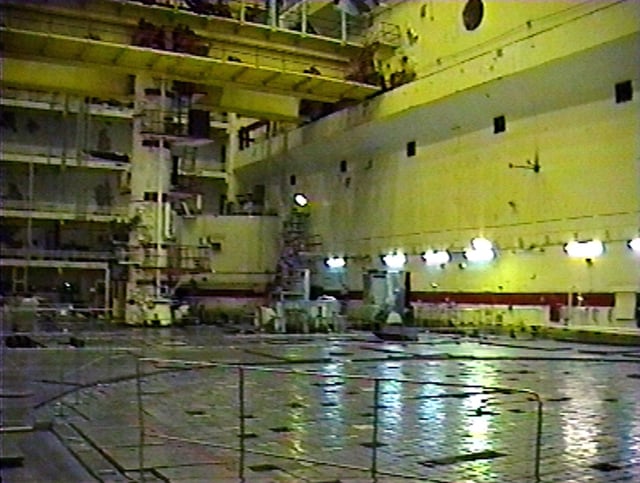
Reactor hall No. 1 of the Chernobyl Plant
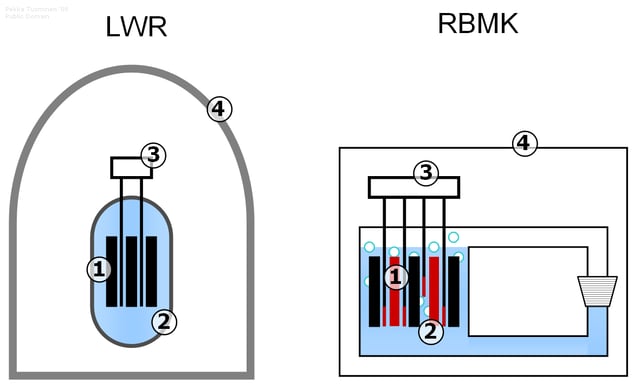
A simplified diagram of the major differences between the Chernobyl RBMK and the most common nuclear reactor design, the Light water reactor. 1. The use of a graphite moderator in a water cooled reactor, permitting criticality in a total loss of coolant accident. 2. A positive steam void coefficient that made the power excursion possible, which blew the reactor vessel. 3. The control rods were very slow, taking 18–20 seconds to be deployed. With the control rods having graphite tips that moderated and therefore increased the fission rate in the beginning of the rod insertion. 4. No reinforced containment building.[33][35][112]
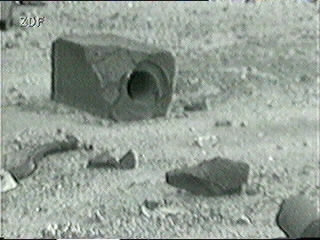
Lumps of graphite moderator ejected from the core; the largest lump shows an intact control rod channel
Ukraine had declassified a number of KGB documents from the period between 1971 and 1988 related to the Chernobyl plant, mentioning for example previous reports of structural damages caused by negligence during construction of the plant (such as splitting of concrete layers) that were never acted upon. They document more than 29 emergency situations in the plant during this period, eight of which were caused by negligence or poor competence on the part of personnel.[113]
In 1991 a Commission of the USSR State Committee for the Supervision of Safety in Industry and Nuclear Power reassessed the causes and circumstances of the Chernobyl accident and came to new insights and conclusions. Based on it, in 1992 the IAEA Nuclear Safety Advisory Group (INSAG) published an additional report, INSAG-7,[33] that reviewed "that part of the INSAG-1 report in which primary attention is given to the reasons for the accident," and was included the USSR State Commission report as Appendix I.[33]
In this INSAG report, most of the earlier accusations against staff for breach of regulations were acknowledged to be either erroneous, based on incorrect information obtained in August 1986, or less relevant. This report reflected a different view of the main reasons for the accident, presented in Appendix I. According to this account, the operators' actions in turning off the Emergency Core Cooling System, interfering with the settings on the protection equipment, and blocking the level and pressure in the separator drum did not contribute to the original cause of the accident and its magnitude, although they may have been a breach of regulations. In fact, turning off the emergency system designed to prevent the two turbine generators from stopping was not a violation of regulations.[33]
Human factors, however, contributed to the conditions that led to the disaster. These included operating the reactor at a low power level—less than 700 MW—a level documented in the run-down test programme, and operating with a small operational reactivity margin (ORM). The 1986 assertions of Soviet experts notwithstanding, regulations did not prohibit operating the reactor at this low power level.[33] []
However, regulations did forbid operating the reactor with a small margin of reactivity. Yet "post-accident studies have shown that the way in which the real role of the ORM is reflected in the Operating Procedures and design documentation for the RBMK-1000 is extremely contradictory", and furthermore, "ORM was not treated as an operational safety limit, violation of which could lead to an accident".[33] []
The reactor had a dangerously large positive void coefficient of reactivity. The void coefficient is a measurement of how a reactor responds to increased steam formation in the water coolant. Most other reactor designs have a negative coefficient, i.e. the nuclear reaction rate slows when steam bubbles form in the coolant, since as the vapour phase in the reactor increases, fewer neutrons are slowed down. Faster neutrons are less likely to split uranium atoms, so the reactor produces less power (a negative feedback). Chernobyl's RBMK reactor, however, used solid graphite as a neutron moderator to slow down the neutrons, and the water in it, on the contrary, acts like a harmful neutron absorber. Thus neutrons are slowed down even if steam bubbles form in the water. Furthermore, because steam absorbs neutrons much less readily than water, increasing the intensity of vapourization means that more neutrons are able to split uranium atoms, increasing the reactor's power output. This makes the RBMK design very unstable at low power levels, and prone to suddenly increasing energy production to a dangerous level. This behaviour is counter-intuitive, and this property of the reactor was unknown to the crew.
A more significant flaw was in the design of the control rods that are inserted into the reactor to slow down the reaction. In the RBMK reactor design, the lower part of each control rod was made of graphite and was 1.3 metres (4.3 ft) shorter than necessary, and in the space beneath the rods were hollow channels filled with water. The upper part of the rod, the truly functional part that absorbs the neutrons and thereby halts the reaction, was made of boron carbide. With this design, when the rods are inserted into the reactor from the uppermost position, the graphite parts initially displace some water (which absorbs neutrons, as mentioned above), effectively causing fewer neutrons to be absorbed initially. Thus for the first few seconds of control rod activation, reactor power output is increased, rather than reduced as desired. This behaviour is counter-intuitive and was not known to the reactor operators.
Other deficiencies besides these were noted in the RBMK-1000 reactor design, as were its non-compliance with accepted standards and with the requirements of nuclear reactor safety. While INSAG-1 and INSAG-7 reports both identified operator error as an issue of concern, the INSAG-7 identified that there were numerous other issues that were contributing factors that led to the incident. These contributing factors include:
The plant was not designed to safety standards in effect and incorporated unsafe features
"Inadequate safety analysis" was performed[33]
There was "insufficient attention to independent safety review"[33]
"Operating procedures not founded satisfactorily in safety analysis"[33]
Safety information not adequately and effectively communicated between operators, and between operators and designers
The operators did not adequately understand safety aspects of the plant
Operators did not sufficiently respect formal requirements of operational and test procedures
The regulatory regime was insufficient to effectively counter pressures for production
There was a "general lack of safety culture in nuclear matters at the national level as well as locally"[33]
Analysis
Both views were heavily lobbied by different groups, including the reactor's designers, power plant personnel, and the Soviet and Ukrainian governments. According to the IAEA's 1986 analysis, the main cause of the accident was the operators' actions. But according to the IAEA's 1993 revised analysis the main cause was the reactor's design.[114] One reason there were such contradictory viewpoints and so much debate about the causes of the Chernobyl accident was that the primary data covering the disaster, as registered by the instruments and sensors, were not completely published in the official sources.
Once again, the human factor had to be considered as a major element in causing the accident. INSAG notes that both the operating regulations and staff handled the disabling of the reactor protection easily enough: witness the length of time for which the ECCS was out of service while the reactor was operated at half power. INSAG's view is that it was the operating crew's deviation from the test programme that was mostly to blame. "Most reprehensibly, unapproved changes in the test procedure were deliberately made on the spot, although the plant was known to be in a very different condition from that intended for the test."[33] []
As in the previously released report INSAG-1, close attention is paid in report INSAG-7 to the inadequate (at the moment of the accident) "culture of safety" at all levels. Deficiency in the safety culture was inherent not only at the operational stage but also, and to no lesser extent, during activities at other stages in the lifetime of nuclear power plants (including design, engineering, construction, manufacture, and regulation). The poor quality of operating procedures and instructions, and their conflicting character, put a heavy burden on the operating crew, including the chief engineer. "The accident can be said to have flowed from a deficient safety culture, not only at the Chernobyl plant, but throughout the Soviet design, operating and regulatory organizations for nuclear power that existed at that time."[33] []
Impact
Environmental
Spread of radioactive substances
Although no informing comparisons can be made between the accident and a strictly air burst-fuzed nuclear detonation, it has still been approximated that about four hundred times more radioactive material was released from Chernobyl than by the atomic bombing of Hiroshima and Nagasaki. By contrast the Chernobyl accident released about one hundredth to one thousandth of the total amount of radioactivity released during the era of nuclear weapons testing at the height of the Cold War, 1950–1960s, with the 1/100 to 1/1000 variance due to trying to make comparisons with different spectrums of isotopes released.[115] Approximately 100,000 square kilometres (39,000 sq mi) of land was significantly contaminated with fallout, with the worst hit regions being in Belarus, Ukraine and Russia.[116] Slighter levels of contamination were detected over all of Europe except for the Iberian Peninsula.[117][118][119]
The initial evidence that a major release of radioactive material was affecting other countries came not from Soviet sources, but from Sweden. On the morning of 28 April,[120] workers at the Forsmark Nuclear Power Plant (approximately 1,100 km (680 mi) from the Chernobyl site) were found to have radioactive particles on their clothes.[121]
It was Sweden's search for the source of radioactivity, after they had determined there was no leak at the Swedish plant, that at noon on 28 April, led to the first hint of a serious nuclear problem in the western Soviet Union. Hence the evacuation of Pripyat on 27 April 36 hours after the initial explosions, was silently completed before the disaster became known outside the Soviet Union. The rise in radiation levels had at that time already been measured in Finland, but a civil service strike delayed the response and publication.[122]
| Country | 37–185 kBq/m2 | 185–555 kBq/m2 | 555–1,480 kBq/m2 | 1,480 kBq/m2 | ||||
|---|---|---|---|---|---|---|---|---|
| km2 | % of country | km2 | % of country | km2 | % of country | km2 | % of country | |
| Belarus | 29,900 | 14.4 | 10,200 | 4.9 | 4,200 | 2.0 | 2,200 | 1.1 |
| Ukraine | 37,200 | 6.2 | 3,200 | 0.53 | 900 | 0.15 | 600 | 0.1 |
| Russia | 49,800 | 0.29 | 5,700 | 0.03 | 2,100 | 0.01 | 300 | 0.002 |
| Sweden | 12,000 | 2.7 | — | — | — | — | — | — |
| Finland | 11,500 | 3.4 | — | — | — | — | — | — |
| Austria | 8,600 | 10.3 | — | — | — | — | — | — |
| Norway | 5,200 | 1.3 | — | — | — | — | — | — |
| Bulgaria | 4,800 | 4.3 | — | — | — | — | — | — |
| Switzerland | 1,300 | 3.1 | — | — | — | — | — | — |
| Greece | 1,200 | 0.91 | — | — | — | — | — | — |
| Slovenia | 300 | 1.5 | — | — | — | — | — | — |
| Italy | 300 | 0.1 | — | — | — | — | — | — |
| Moldova | 60 | 0.2 | — | — | — | — | — | — |
| Totals | 162,160 km2 | 19,100 km2 | 7,200 km2 | 3,100 km2 | ||||
Contamination from the Chernobyl accident was scattered irregularly depending on weather conditions, much of it deposited on mountainous regions such as the Alps, the Welsh mountains and the Scottish Highlands, where adiabatic cooling caused radioactive rainfall. The resulting patches of contamination were often highly localized, and water-flows across the ground contributed further to large variations in radioactivity over small areas. Sweden and Norway also received heavy fallout when the contaminated air collided with a cold front, bringing rain.[124] [] There was also groundwater contamination.
Rain was purposely seeded over 10,000 square kilometres (3,900 sq mi) of the Belorussian SSR by the Soviet air force to remove radioactive particles from clouds heading toward highly populated areas. Heavy, black-coloured rain fell on the city of Gomel.[125] Reports from Soviet and Western scientists indicate that Belarus received about 60% of the contamination that fell on the former Soviet Union. However, the 2006 TORCH report stated that half of the volatile particles had landed outside Ukraine, Belarus, and Russia. A large area in Russia south of Bryansk was also contaminated, as were parts of northwestern Ukraine. Studies in surrounding countries indicate that more than one million people could have been affected by radiation.[126]
Recently published data from a long-term monitoring program (The Korma Report II)[127] shows a decrease in internal radiation exposure of the inhabitants of a region in Belarus close to Gomel. Resettlement may even be possible in prohibited areas provided that people comply with appropriate dietary rules.
In Western Europe, precautionary measures taken in response to the radiation included seemingly arbitrary regulations banning the importation of certain foods but not others. In France officials stated that the Chernobyl accident had no adverse effects.[128]
Radioactive release

Contributions of the various isotopes to the atmospheric absorbed dose in the contaminated area of Pripyat, from soon after the accident to 27 years after the accident
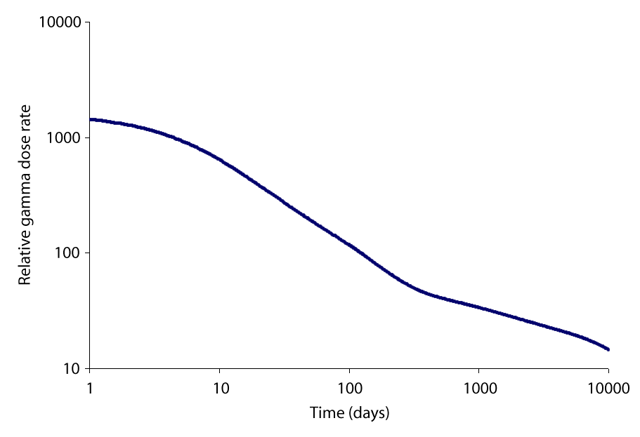
External relative gamma dose for a person in the open near the disaster site
Like many other releases of radioactivity into the environment, the Chernobyl release was controlled by the physical and chemical properties of the radioactive elements in the core. Particularly dangerous are the highly radioactive fission products, those with high nuclear decay rates that accumulate in the food chain, such as some of the isotopes of iodine, caesium and strontium. Iodine-131 was and caesium-137 remains the two most responsible for the radiation exposure received by the general population.[11]
At different times after the accident, different isotopes were responsible for the majority of the external dose. The remaining quantity of any radioisotope, and therefore the activity of that isotope, after 7 decay half-lives have passed, is less than 1% of its initial magnitude,[131] and it continues to reduce beyond 0.78% after 7 half-lives to 0.10% remaining after 10 half-lives have passed and so on.[132][133] Some radionuclides have decay products that are likewise radioactive, which is not accounted for here. The release of radioisotopes from the nuclear fuel was largely controlled by their boiling points, and the majority of the radioactivity present in the core was retained in the reactor.
All of the noble gases, including krypton and xenon, contained within the reactor were released immediately into the atmosphere by the first steam explosion.[11] The atmospheric release of xenon-133, with a half-life of 5 days, is estimated at 5200 PBq.[11]
50 to 60% of all core radioiodine in the reactor, about 1760 PBq (1760×1015 becquerels), or about 0.4 kilograms (0.88 lb), was released, as a mixture of sublimed vapour, solid particles, and organic iodine compounds. Iodine-131 has a half-life of 8 days.[11]
20 to 40% of all core caesium-137 was released, 85 PBq in all.[11][134] Caesium was released in aerosol form; caesium-137, along with isotopes of strontium, are the two primary elements preventing the Chernobyl exclusion zone being re-inhabited.[135] 8.5×1016 Bq equals 24 kilograms of caesium-137.[135] Cs-137 has a half-life of 30 years.[11]
Tellurium-132, half-life 78 hours, an estimated 1150 PBq was released.[11]
An early estimate for total nuclear fuel material released to the environment was 3±1.5%; this was later revised to 3.5±0.5%. This corresponds to the atmospheric emission of 6 metric tons (5.9 long tons; 6.6 short tons) of fragmented fuel.[130]
Two sizes of particles were released: small particles of 0.3 to 1.5 micrometres, each an individually unrecognizable small dust or smog sized particulate matter and larger settling dust sized particles that therefore were quicker to fall-out of the air, of 10 micrometres in diameter. These larger particles contained about 80% to 90% of the released high boiling point or non-volatile radioisotopes; zirconium-95, niobium-95, lanthanum-140, cerium-144 and the transuranic elements, including neptunium, plutonium and the minor actinides, embedded in a uranium oxide matrix.
The dose that was calculated is the relative external gamma dose rate for a person standing in the open. The exact dose to a person in the real world who would spend most of their time sleeping indoors in a shelter and then venturing out to consume an internal dose from the inhalation or ingestion of a radioisotope, requires a personnel specific radiation dose reconstruction analysis and whole body count exams, of which 16,000 were conducted in Ukraine by Soviet medical personnel in 1987.[136]
Residual radioactivity
Map of current radiation levels of Chernobyl Nuclear Power Plant and surrounds [282]
Water bodies
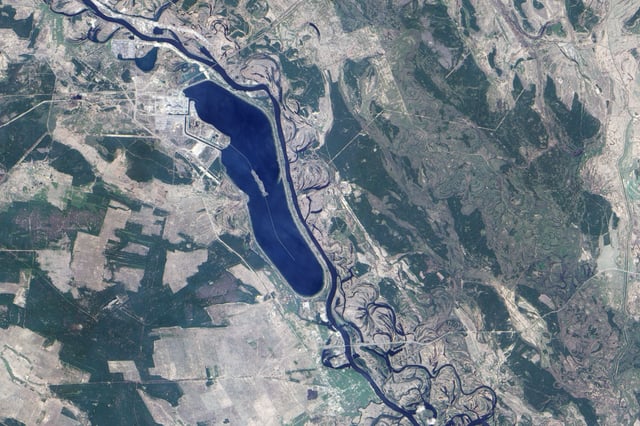
Reactor and surrounding area in April 2009

Radiation levels in 1996 around Chernobyl
The Chernobyl nuclear power plant is located next to the Pripyat River, which feeds into the Dnieper reservoir system, one of the largest surface water systems in Europe, which at the time supplied water to Kiev's 2.4 million residents, and was still in spring flood when the accident occurred.[75] [] The radioactive contamination of aquatic systems therefore became a major problem in the immediate aftermath of the accident.[137]
In the most affected areas of Ukraine, levels of radioactivity (particularly from radionuclides 131I, 137Cs and 90Sr) in drinking water caused concern during the weeks and months after the accident,[137] Guidelines for levels of radioiodine in drinking water were temporarily raised to 3,700 Bq/L, allowing most water to be reported as safe,[137] [137] Officially it was stated that all contaminants had settled to the bottom "in an insoluble phase" and would not dissolve for 800–1000 years.[75] [] A year after the accident it was announced that even the water of the Chernobyl plant's cooling pond was within acceptable norms. Despite this, two months after the disaster the Kiev water supply was switched from the Dnieper to the Desna River.[75] [] Meanwhile, massive silt traps were constructed, along with an enormous 30-metre (98 ft) deep underground barrier to prevent groundwater from the destroyed reactor entering the Pripyat River.[75] []
Groundwater was not badly affected by the Chernobyl accident since radionuclides with short half-lives decayed away long before they could affect groundwater supplies, and longer-lived radionuclides such as radiocaesium and radiostrontium were adsorbed to surface soils before they could transfer to groundwater.[138] However, significant transfers of radionuclides to groundwater have occurred from waste disposal sites in the 30 km (19 mi) exclusion zone around Chernobyl. Although there is a potential for transfer of radionuclides from these disposal sites off-site (i.e. out of the 30 km (19 mi) exclusion zone), the IAEA Chernobyl Report[138] argues that this is not significant in comparison to current levels of washout of surface-deposited radioactivity.
Bio-accumulation of radioactivity in fish[139] resulted in concentrations (both in western Europe and in the former Soviet Union) that in many cases were significantly above guideline maximum levels for consumption.[137] Guideline maximum levels for radiocaesium in fish vary from country to country but are approximately 1000 Bq/kg in the European Union.[140] In the Kiev Reservoir in Ukraine, concentrations in fish were in the range of 3000 Bq/kg during the first few years after the accident.[139]
In small "closed" lakes in Belarus and the Bryansk region of Russia, concentrations in a number of fish species varied from 100 to 60,000 Bq/kg during the period 1990–92.[141] The contamination of fish caused short-term concern in parts of the UK and Germany and in the long term (years rather than months) in the affected areas of Ukraine, Belarus, and Russia as well as in parts of Scandinavia.[137]
Flora and fauna
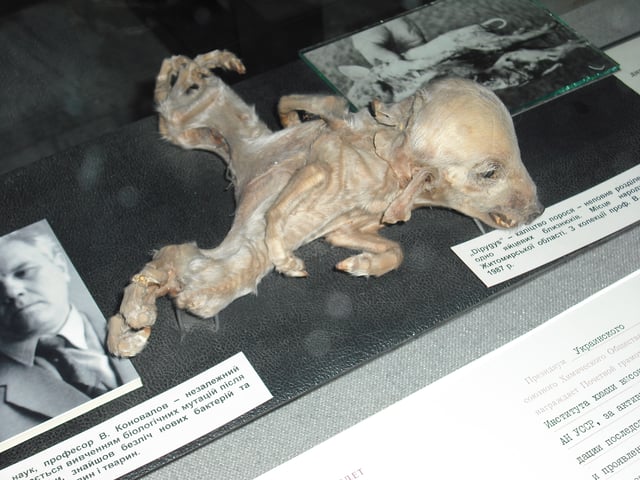
Piglet with dipygus on exhibit at the Ukrainian National Chornobyl Museum
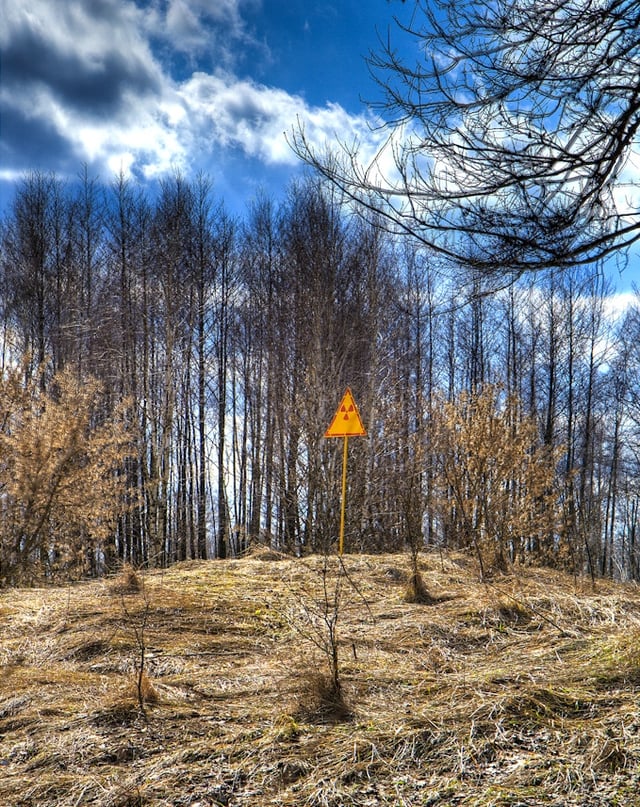
After the disaster, four square kilometres (1.5 sq mi) of pine forest directly downwind of the reactor turned reddish-brown and died, earning the name of the "Red Forest", though it soon recovered.[142] This photograph was taken years later, in March 2009,[145] after the forest began to grow again, with the lack of foliage at the time of the photograph merely due to the local winter at the time.[146]
After the disaster, four square kilometres (1.5 sq mi) of pine forest directly downwind of the reactor turned reddish-brown and died, earning the name of the "Red Forest".[142] Some animals in the worst-hit areas also died or stopped reproducing. Most domestic animals were removed from the exclusion zone, but horses left on an island in the Pripyat River 6 km (4 mi) from the power plant died when their thyroid glands were destroyed by radiation doses of 150–200 Sv.[143] Some cattle on the same island died and those that survived were stunted because of thyroid damage. The next generation appeared to be normal.[143]
On farms in Narodychi Raion of Ukraine it is claimed that from 1986-1990 nearly 350 animals were born with gross deformities such as missing or extra limbs, missing eyes, heads or ribs, or deformed skulls; in comparison, only three abnormal births had been registered in the five years prior.[144]
With radiocaesium binding less with humic acid, peaty soils than the known binding "fixation" that occurs on kaolinite rich clay soils, many marshy areas of Ukraine had the highest soil to dairy-milk transfer coefficients, of soil activity in ~ 200 kBq/m2 to dairy milk activity in Bq/L, that had ever been reported, with the transfer, from initial land activity into milk activity, ranging from 0.3−2 to 20−2 times that which was on the soil, a variance depending on the natural acidicity-conditioning of the pasture.[136]
In 1987, Soviet medical teams conducted some 16,000 whole-body count examinations in these otherwise comparatively lightly contaminated regions deemed good prospects for recovery, to determine the completeness of banning local food and subsisting on food imports on the internal body burden of inhabitants, while concurrent agricultural countermeasures were fielded when cultivation did occur to further reduce the soil to human transfer as much as possible. The expected highest body activity was in the first few years, were the unabated ingestion of local food, primarily milk consumption, resulted in the transfer of activity from soil to body, after the dissolution of the USSR, the now-reduced scale initiative to monitor the human body activity in these regions of Ukraine, recorded a small and gradual half-decadal-long rise, in internal committed dose, before returning to the previous trend of observing ever lower body counts each year.
This momentary rise is hypothesized to be due to the cessation of the Soviet food imports together with many villagers returning to older dairy food cultivation practices and large increases in wild berry and mushroom foraging, the latter of which have similar peaty soil to fruiting body, radiocaesium transfer coefficients.[136]
In a 2007 paper, a robot sent into the reactor itself returned with samples of black, melanin-rich radiotrophic fungi that grow on the reactor's walls.[147]
Of the 440,350 wild boar killed in the 2010 hunting season in Germany, approximately one thousand were contaminated with levels of radiation above the permitted limit of 600 becquerels of caesium per kilogram, of dry weight, due to residual radioactivity from Chernobyl.[148] While all animal meat contains a natural level of potassium 40 at a similar level of activity, with both wild and farm animals in Italy containing "415 ± 56 becquerels kg−1 dw" of that naturally occurring gamma emitter.[149]
The caesium contamination issue has historically reached some uniquely isolated and high levels approaching 20,000 Becquerels of caesium per kilogram in some specific tests; however, it has not been observed in the wild boar population of Fukushima after the 2011 accident.[150] Evidence exists to suggest that the wild German and Ukrainian boar population are in a unique location were they have subsisted on a diet high in plant or fungi sources that biomagnifies or concentrates radiocaesium, with the most well known food source the consumption of the outer shell or wall of the "deer-truffle" elaphomyces which, along with magnifying radiocaesium, also magnifies or concentrates natural soil concentrations of arsenic.[151]
In 2015, long-term empirical data showed no evidence of a negative influence of radiation on mammal abundance.[152]
When clouds arrive at mountain ranges, the thermal air rises over the hotter land, causing weather front adiabatic cooling within the cloud, and on cooling, frequent percipitation or rainout occurs, with an eventual formation of localized concentrations of contaminants in the area, creating contaminant hotspots, with activities in these distant mountain areas, higher in Bq/m2 values to many areas much closer to the source of the plume. The Norwegian Agricultural Authority reported that in 2009 a total of 18,000 livestock in Norway required uncontaminated feed for a period before slaughter, to ensure that their meat had an activity below the government permitted value of cesium per kilogram deemed suitable for human consumption. This contamination was due to residual radioactivity from Chernobyl in the mountain plants they graze on in the wild during the summer. 1,914 sheep required uncontaminated feed for a time before slaughter during 2012, with these sheep located in only 18 of Norway's municipalities, a decrease from the 35 municipalities in 2011 and the 117 municipalities affected during 1986.[153]
The after-effects of Chernobyl on the mountain lamb industry in Norway were expected to be seen for a further 100 years, although the severity of the effects would decline over that period.[154] Scientists report this is due to radioactive caesium-137 isotopes being taken up by fungi such as Cortinarius caperatus which is in turn eaten by sheep while grazing.[153]
The United Kingdom restricted the movement of sheep from upland areas when radioactive caesium-137 fell across parts of Northern Ireland, Wales, Scotland, and northern England. In the immediate aftermath of the disaster in 1986, the movement of a total of 4,225,000 sheep was restricted across a total of 9,700 farms, to prevent contaminated meat entering the human food chain.[155] The number of sheep and the number of farms affected has decreased since 1986. Northern Ireland was released from all restrictions in 2000, and by 2009, 369 farms containing around 190,000 sheep remained under the restrictions in Wales, Cumbria, and northern Scotland.[155] The restrictions applying in Scotland were lifted in 2010, while those applying to Wales and Cumbria were lifted during 2012, meaning no farms in the UK remain restricted because of Chernobyl fallout.[156][157]
The legislation used to control sheep movement and compensate farmers (farmers were latterly compensated per animal to cover additional costs in holding animals prior to radiation monitoring) was revoked during October and November 2012, by the relevant authorities in the UK.[158] Had restrictions in the UK not occurred, a heavy consumer of lamb meat would likely have received a dose of 0.04 mSv over a lifetime.[21]
Human
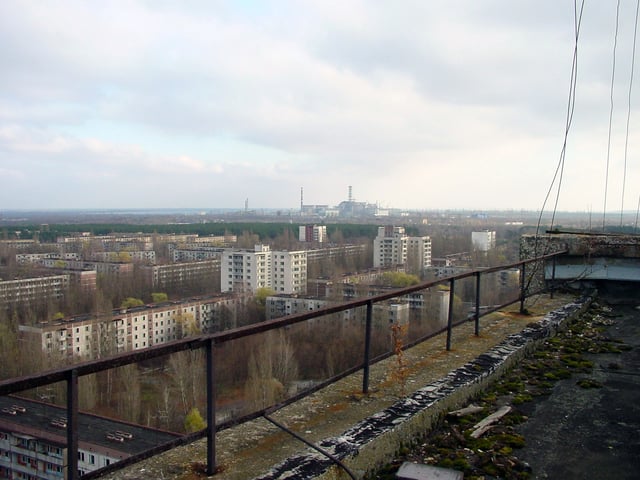
Pripyat lies abandoned with the Chernobyl facility visible in the distance
In the accident's aftermath, 237 people suffered from acute radiation sickness, of whom 31 died within the first three months.[159][160] In 2005, the Chernobyl Forum, composed of the International Atomic Energy Agency, other UN organizations, and the governments of Belarus, Russia and Ukraine, published a report on the radiological environmental and health consequences of the Chernobyl accident. In September 1987, the I.A.E.A. held an Advisory Group Meeting at the Curie Institute in Paris on the medical handling of the skin lesions relating to the acute deaths.[161]
The only known, causal deaths from the accident involved workers in the plant and firefighters. In reporter Grigori Medvedev's book on the accident, there were a number of fishermen on the reservoir a half-kilometer from the reactor to the east. Of these, two shore fishermen, Protosov and Pustavoit, are said to have sustained doses estimated at 400 roentgens, vomited, but survived.[42][43] The vast majority of Pripyat residents slept through the distant sound of the explosion, including station engineer Breus, who only became aware at 6am, the beginning of his next work shift. He would later be taken to hospital and, while there, made the acquaintance of one teen who had ventured out alone by bicycle to watch the roof fires during the night, stopping for a time and viewing the scene at the fictitious "Bridge of Death" 51°23′42″N 30°04′10″E [283] , however contrary to this sensationalist label, the youthful night biker was treated and released from hospital, remaining in touch with Breus as of 2019.[162][163][164]
With the exception of plant employee Shashenock, who having been struck by injuries compounded by the blast and never fully regaining consciousness, upon the arrival of the world specialist, all serious cases of ARS were treated by Dr. Robert Peter Gale, who documented a first of its kind treatment.[165][166] In 2019, Gale would write a letter to correct the popularised, though egregious, protrayal of his patients as dangerous to visitors.[167] All those who died were station operators and firefighters, over half of which from the continued wearing of dusty soaked uniforms, causing beta burns to cover large areas of skin. In the first few minutes to days, (largely due to Np-239, a 2.4-day half-life) the beta-to-gamma energy ratio is some 30:1, though while adding to the dose, no proximate deaths would be from the gamma fraction of exposure.[168][169][170] Instead, owing to the large area of burned skin, bacterial infection was and remains the over-arching concern to those afflicted with ARS, as a leading cause of death, quarantine from the outside environment is a part of the normal treatment protocol. Many of the surviving firefighters, continue to have skin that is atrophied, spider veined with underlying fibrosis due to experiencing extensive beta burns.[170]
The eventual medical report states that in those who were treated for ARS, 28 died from the acute radiation syndrome, each over the following days to months. In the years afterward, 15 people have died from thyroid cancer; it is roughly estimated that cancer deaths caused by Chernobyl may reach a total of about 4,000 among the five million persons residing in the contaminated areas. The report projected cancer mortality "increases of less than one per cent" (~0.3%) on a time span of 80 years, cautioning that this estimate was "speculative" since at this time only a few cancer deaths are linked to the Chernobyl disaster.[171] The report says it is impossible to reliably predict the number of fatal cancers arising from the incident as small differences in assumptions can result in large differences in the estimated health costs. The report says it represents the consensus view of the eight UN organizations.
Of all 66,000 Belarusian emergency workers, by the mid-1990s their government reported that only 150 (roughly 0.2%) died. In contrast, in the much larger work force from Ukraine, numbered in the hundreds of thousands, some 5,722 casualties from a host of non-accident causes, were reported among Ukrainian clean-up workers up to the year 1995, by the National Committee for Radiation Protection of the Ukrainian Population.[116][172]
The four most harmful radionuclides spread from Chernobyl were iodine-131, caesium-134, caesium-137 and strontium-90, with half-lives of 8.02 days, 2.07 years, 30.2 years and 28.8 years respectively.[173] [] The iodine was initially viewed with less alarm than the other isotopes, because of its short half-life, but it is highly volatile and now appears to have travelled furthest and caused the most severe health problems.[116] [] Strontium, on the other hand, is the least volatile of the four and is of main concern in the areas near Chernobyl itself.[173] [] Iodine tends to become concentrated in thyroid and milk glands, leading, among other things, to increased incidence of thyroid cancers. The total ingested dose was largely from iodine and, unlike the other fission products, rapidly found its way from dairy farms to human ingestion.[174] Similarly in dose reconstruction, for those evacuated at different times and from various towns, the inhalation dose was dominated by iodine (40%), along with airborne tellurium (20%) and oxides of rubidium (20%) both as equally secondary, appreciable contributors.[175]
Long term hazards such as caesium tends to accumulate in vital organs such as the heart,[176] while strontium accumulates in bones and may thus be a risk to bone-marrow and lymphocytes.[173] [] Radiation is most damaging to cells that are actively dividing. In adult mammals cell division is slow, except in hair follicles, skin, bone marrow and the gastrointestinal tract, which is why vomiting and hair loss are common symptoms of acute radiation sickness.[177] []
Assessment complications
By the year 2000, the number of Ukrainians claiming to be radiation 'sufferers' (poterpili) and receiving state benefits had jumped to 3.5 million, or 5% of the population. Many of these are populations resettled from contaminated zones or former or current Chernobyl plant workers.[108] [] There was and remains a motivated 'push' to achieve 'sufferer' status as it gives access to state benefits and medical services that would otherwise not be made available.[178] According to IAEA-affiliated scientific bodies, the apparent increases of ill health in this large group result partly from economic strains on these countries and poor health-care and nutrition; also, they suggest that increased medical vigilance following the accident, particularly a heightened overdiagnosis due to the Screening effect, has meant that many benign cases that would previously have gone unnoticed and untreated (especially of cancer) are now being registered.[116]
The World Health Organization states, "children conceived before or after their father's exposure showed no statistically significant differences in mutation frequencies".[179] This statistically insignificant increase was also seen by independent researchers analyzing the children of the Chernobyl liquidators.[180]
The two primary individuals involved with the attempt to suggest that the mutation rate among animals was, and continues to be, higher in the Chernobyl zone, are the Anders Moller and Timothy Mousseau group.[181][182][183][184] Apart from continuing to publish experimentally unrepeatable and discredited papers, Mousseau routinely gives talks at the Helen Caldicott organized symposiums for "Physicians for Social Responsibility", an anti-nuclear advocacy group devoted to bring about a "nuclear free planet".[185] Moreover, in years past, Moller was previously caught and reprimanded for publishing papers that crossed the scientific "misconduct"/"fraud" line.[186] The duo have more recently attempted to publish meta-analyses, in which the primary references they weigh-up, analyze and draw their conclusions from is their own prior papers along with the discredited book Chernobyl: Consequences of the Catastrophe for People and the Environment.[187]
In 1996, geneticist colleagues Ronald Chesser and Robert Baker published a paper on the thriving vole population within the exclusion zone, in which the central conclusion of their work was essentially that "The mutation rate in these animals is hundreds and probably thousands of times greater than normal". This claim occurred after they had done a comparison of the mitochondrial DNA of the "Chernobyl voles" with that of a control group of voles from outside the region.[188] These alarming conclusions led the paper to appear on the front cover of the prestigious journal Nature. However, not long after publication, Chesser & Baker discovered a fundamental error in the interpretation of their data, and despite only the authors recognizing the error in which they had incorrectly classified the species of vole and therefore were comparing the genetics of two entirely different vole species to start with, the team made the decision to issue a retraction.[181][189]
Abortions
Following the accident, journalists mistrusted many medical professionals (such as the spokesman from the UK National Radiological Protection Board), and in turn encouraged the public to mistrust them.[190] Throughout the European continent, due to this media-driven framing of the slight contamination and in nations where abortion is legal, many requests for induced abortions of otherwise normal pregnancies, were obtained out of fears of radiation from Chernobyl, including an excess number of abortions in Denmark in the months following the accident.[191]
In Greece, following the accident, many obstetricians were unable to resist requests from worried pregnant mothers over fears of radiation. Although it was determined that the effective dose to Greeks would not exceed one mSv (100 mrem), a dose much lower than that which could induce embryonic abnormalities or other non-stochastic effects, there was an observed 2,500 excess of otherwise wanted pregnancies being terminated, probably out of fear in the mother of radiation risk.[192] A slightly above the expected number of requested induced abortions occurred in Italy.[193][194]
Worldwide, an estimated excess of about 150,000 elective abortions may have been performed on otherwise healthy pregnancies out of fears of radiation from Chernobyl, according to Robert Baker and ultimately a 1987 article published by Linda E. Ketchum in the Journal of Nuclear Medicine which mentions but does not reference an IAEA source on the matter.[190][191][192][195][196][197]
The available statistical data excludes the Soviet–Ukraine–Belarus abortion rates, as they are presently unavailable. From the available data, an increase in the number of abortions in what were healthy developing human offspring in Denmark occurred in the months following the accident, at a rate of about 400 cases.[191] In Greece, there was an observed 2,500 excess of otherwise wanted pregnancies being terminated.[192] In Italy, a "slightly" above the expected number of induced abortions occurred, approximately 100.[193][194]
No evidence of changes in the prevalence of human deformities/birth congenital anomalies that might be associated with the accident are apparent in Belarus or the Ukraine, the two republics that had the highest exposure to fallout.[198] In Sweden[199] and Finland where no increase in abortion rates occurred, it was likewise determined that "no association between the temporal and spatial variations in radioactivity and variable incidence of congenital malformations [was found]."[200] A similar null increase in the abortion rate and a healthy baseline situation of no increase in birth defects was determined by assessing the Hungarian Congenital Abnormality Registry.[201] Findings were also mirrored in Austria.[202] Larger "mainly western European" data sets, approaching a million births in the EUROCAT database, divided into "exposed" and control groups were assessed in 1999. As no Chernobyl impacts were detected, the researchers conclude "in retrospect, the widespread fear in the population about the possible effects of exposure on the unborn fetus was not justified".[203] Despite studies from Germany and Turkey, the only robust evidence of negative pregnancy outcomes that transpired after the accident were these elective abortion indirect effects, in Greece, Denmark, Italy etc., due to the anxieties that were created.[198]
In very high doses, it was known at the time that radiation could cause a physiological increase in the rate of pregnancy anomalies, but unlike the dominant linear-no threshold model of radiation and cancer rate increases, it was known, by researchers familiar with both the prior human exposure data and animal testing, that the "Malformation of organs appears to be a deterministic effect with a threshold dose" below which, no rate increase is observed.[204] This teratology (birth defects) issue was discussed by Frank Castronovo of the Harvard Medical School in 1999, publishing a detailed review of dose reconstructions and the available pregnancy data following the Chernobyl accident, inclusive of data from Kiev's two largest obstetrics hospitals.[204] Castronovo concludes that "the lay press with newspaper reporters playing up anecdotal stories of children with birth defects" is, together with dubious studies that show selection bias, the two primary factors causing the persistent belief that Chernobyl increased the background rate of birth defects. When the vast amount of pregnancy data does not support this perception as no women took part in the most radioactive liquidator operations, no in-utero individuals would have been expected to have received a threshold dose.[204]
In one small behavioral study in 1998, with low statistical power and limited multivariate analysis which, akin to the widely published Hiroshima and Nagasaki studies, investigated and selected the children; who were in utero during the rapidly dividing and therefore radiosensitive phase of neurogenesis (8 to 16 weeks of gestation), and whose mothers were evacuated from some of the more energetic hot-spot parts of the Chernobyl exclusion zone following the accident. From a random selection of 50 individuals in late-childhood in 1998, a low quality statistically-significant increase in the rate of severe IQ reduction was found, with a threshold of a suggested ~ 0.30 Sv (300 mSv) as a thyroid dose to the developing human head, for the beginning emergence of cerebral disorder.[205][206]
The Chernobyl liquidators, essentially an all-male civil defense emergency workforce, would go on to father normal children, without an increase in developmental anomalies or a statistically significant increase in the frequencies of germline mutations in their progeny.[180] This normality is similarly seen in the children of the survivors of the Goiana accident.[207]
Cancer assessments

Thyroid cancer incidence in children and adolescents in Belarus Adults, ages 19 to 34 Adolescents, ages 15 to 18 Children, ages up to 14 While widely regarded as having a cause and effect relationship, the causality of Chernobyl with the increases in recorded rates of thyroid cancer is disputed,[214] as in both the US and South Korea, upon the advent of ultrasonography and widespread medical screening, the latter recorded an almost identical epidemic in thyroid cancer rates, with South Korea reporting a 15 fold increase upon the switch of diagnostic tool, the highest thyroid cancer rate in the world.[215]
A report by the International Atomic Energy Agency examines the environmental consequences of the accident.[138] The United Nations Scientific Committee on the Effects of Atomic Radiation has estimated a global collective dose of radiation exposure from the accident "equivalent on average to 21 additional days of world exposure to natural background radiation"; individual doses were far higher than the global mean among those most exposed, including 530,000 primarily male recovery workers (the Chernobyl liquidators) who averaged an effective dose equivalent to an extra 50 years of typical natural background radiation exposure each.[208][209][210]
Estimates of the number of deaths that will eventually result from the accident vary enormously; disparities reflect both the lack of solid scientific data and the different methodologies used to quantify mortality—whether the discussion is confined to specific geographical areas or extends worldwide, and whether the deaths are immediate, short term, or long term. In 1994, thirty-one deaths were directly attributed to the accident, all among the reactor staff and emergency workers.[159]
The Chernobyl Forum predicts that the eventual death toll could reach 4,000 among those exposed to the highest levels of radiation (200,000 emergency workers, 116,000 evacuees and 270,000 residents of the most contaminated areas); this figure is a total causal death toll prediction, combining the deaths of approximately 50 emergency workers who died soon after the accident from acute radiation syndrome, 15 children who have died of thyroid cancer and a future predicted total of 3,935 deaths from radiation-induced cancer and leukaemia.[19]
In a peer-reviewed paper in the International Journal of Cancer in 2006, the authors expanded the discussion on those exposed to all of Europe (but following a different conclusion methodology to the Chernobyl Forum study, which arrived at the total predicted death toll of 4,000 after cancer survival rates were factored in) they stated, without entering into a discussion on deaths, that in terms of total excess cancers attributed to the accident:[211]
The risk projections suggest that by now [2006] Chernobyl may have caused about 1000 cases of thyroid cancer and 4000 cases of other cancers in Europe, representing about 0.01% of all incident cancers since the accident. Models predict that by 2065 about 16,000 cases of thyroid cancer and 25,000 cases of other cancers may be expected due to radiation from the accident, whereas several hundred million cancer cases are expected from other causes.
Two anti-nuclear advocacy groups have publicized non-peer-reviewed estimates that include mortality estimates for those who were exposed to even smaller amounts of radiation. The Union of Concerned Scientists (UCS) calculated that, among the hundreds of millions of people exposed worldwide, there will be an eventual 50,000 excess cancer cases, resulting in 25,000 excess cancer deaths, excluding thyroid cancer.[212] However, these calculations are based on a simple linear no-threshold model multiplication and the misapplication of the collective dose, which the International Commission on Radiological Protection (ICRP) states "should not be done" as using the collective dose is "inappropriate to use in risk projections".[213]
Along similar lines to the UCS approach, the 2006 TORCH report, commissioned by the European Greens political party, likewise simplistically calculates an eventual 30,000 to 60,000 excess cancer deaths in total, around the globe.[117]
Yet the death rate from thyroid cancer has remained the same as prior to the technology.[215] For these and other reasons, it is suggested that no reliable increase has been detected in the environs of Chernobyl, that cannot otherwise be explained as an artifact of the globally well documented Screening effect.[214] In 2004, the UN collaborative, Chernobyl Forum, revealed thyroid cancer among children to be one of the main health impacts from the Chernobyl accident. This is due to the ingestion of contaminated dairy products, along with the inhalation of the short-lived, highly radioactive isotope, Iodine-131. In that publication, more than 4,000 cases of childhood thyroid cancer were reported. It is important to note that there was no evidence of an increase in solid cancers or leukemia. It said that there was an increase in psychological problems among the affected population.[171] The WHO's Radiation Program reported that the 4,000 cases of thyroid cancer resulted in nine deaths.[19]
According to the United Nations Scientific Committee on the Effects of Atomic Radiation, up to the year 2005, an excess of more than 6,000 cases of thyroid cancer had been reported. That is, over the estimated pre-accident baseline thyroid cancer rate, more than 6,000 casual cases of thyroid cancer have been reported in children and adolescents exposed at the time of the accident, a number that is expected to increase. They concluded that there is no other evidence of major health impacts from the radiation exposure.[216]
Well-differentiated thyroid cancers are generally treatable,[217] and when treated the five-year survival rate of thyroid cancer is 96%, and 92% after 30 years.[218] the United Nations Scientific Committee on the Effects of Atomic Radiation had reported 15 deaths from thyroid cancer in 2011.[18] The International Atomic Energy Agency (IAEA) also states that there has been no increase in the rate of birth defects or abnormalities, or solid cancers—such as lung cancer—corroborating the assessments by the UN committee.[171] UNSCEAR raised the possibility of long term genetic defects, pointing to a doubling of radiation-induced minisatellite mutations among children born in 1994.[219] However, the risk of thyroid cancer associated with the Chernobyl accident is still high according to published studies.[220][221]
Other disorders
Fred Mettler, a radiation expert at the University of New Mexico, puts the number of worldwide cancer deaths outside the highly contaminated zone at perhaps 5,000, for a total of 9,000 Chernobyl-associated fatal cancers, saying "the number is small (representing a few percent) relative to the normal spontaneous risk of cancer, but the numbers are large in absolute terms".[224] The same report outlined studies based on data found in the Russian Registry from 1991 to 1998 that suggested that "of 61,000 Russian workers exposed to an average dose of 107 mSv about [five percent] of all fatalities that occurred may have been due to radiation exposure".[171]
The report went into depth about the risks to mental health of exaggerated fears about the effects of radiation.[171] According to the IAEA the "designation of the affected population as "victims" rather than "survivors" has led them to perceive themselves as helpless, weak and lacking control over their future". The IAEA says that this may have led to behaviour that has caused further health effects.[225]
Fred Mettler commented that 20 years later: "The population remains largely unsure of what the effects of radiation actually are and retain a sense of foreboding. A number of adolescents and young adults who have been exposed to modest or small amounts of radiation feel that they are somehow fatally flawed and there is no downside to using illicit drugs or having unprotected sex. To reverse such attitudes and behaviours will likely take years, although some youth groups have begun programs that have promise."[224] In addition, disadvantaged children around Chernobyl suffer from health problems that are attributable not only to the Chernobyl accident, but also to the poor state of post-Soviet health systems.[171]
The United Nations Scientific Committee on the Effects of Atomic Radiation (UNSCEAR), part of the Chernobyl Forum, have produced their own assessments of the radiation effects.[226] UNSCEAR was set up as a collaboration between various United Nation bodies, including the World Health Organization, after the atomic bomb attacks on Hiroshima and Nagasaki, to assess the long-term effects of radiation on human health.[227]
Radiation deaths
The number of potential deaths arising from the Chernobyl disaster is heavily debated. The World Health Organization's prediction of 4,000 future cancer deaths in surrounding countries[228] is based on the Linear no-threshold model (LNT), which assumes that the damage inflicted by radiation at low doses is directly proportional to the dose.[229] Radiation epidemiologist Roy Shore contends that estimating health effects in a population from the LNT model "is not wise because of the uncertainties".[230]
According to the Union of Concerned Scientists the number of excess cancer deaths worldwide (including all contaminated areas) is approximately 27,000 based on the same LNT.[231]
Another study critical of the Chernobyl Forum report was commissioned by Greenpeace, which asserted that the most recently published figures indicate that in Belarus, Russia and Ukraine the accident could have resulted in 10,000–200,000 additional deaths in the period between 1990 and 2004.[232] The Scientific Secretary of the Chernobyl Forum criticized the report's reliance on non-peer-reviewed locally produced studies. Although most of the study's sources were from peer-reviewed journals, including many Western medical journals, the higher mortality estimates were from non-peer-reviewed sources,[232] while Gregory Härtl (spokesman for the WHO) suggested that the conclusions were motivated by ideology.[233]
Chernobyl: Consequences of the Catastrophe for People and the Environment is a 2007 Russian publication that concludes that there were 985,000 premature deaths as a consequence of the radioactivity released.[234] The results were criticized by M. I. Balonov from the Institute of Radiation Hygiene in St. Petersburg, who described them as biased, drawing from sources that were difficult to independently verify and lacking a proper scientific base. Balanov expressed his opinion that "the authors unfortunately did not appropriately analyze the content of the Russian-language publications, for example, to separate them into those that contain scientific evidence and those based on hasty impressions and ignorant conclusions".[234]
According to U.S. Nuclear Regulatory Commission member and Professor of Health Physics Kenneth Mossman,[235] the "LNT philosophy is overly conservative, and low-level radiation may be less dangerous than commonly believed."[236] Yoshihisa Matsumoto, a radiation biologist at the Tokyo Institute of Technology, cites laboratory experiments on animals to suggest there must be a threshold dose below which DNA repair mechanisms can completely repair any radiation damage.[230] Mossman suggests that the proponents of the current model believe that being conservative is justified due to the uncertainties surrounding low level doses and it is better to have a "prudent public health policy".[235]
Another significant issue is establishing consistent data on which to base the analysis of the impact of the Chernobyl accident. Since 1991, large social and political changes have occurred within the affected regions and these changes have had significant impact on the administration of health care, on socio-economic stability, and the manner in which statistical data is collected.[237] Ronald Chesser, a radiation biologist at Texas Tech University, says that "the subsequent Soviet collapse, scarce funding, imprecise dosimetry, and difficulties tracking people over the years have limited the number of studies and their reliability".[230]
Social economic
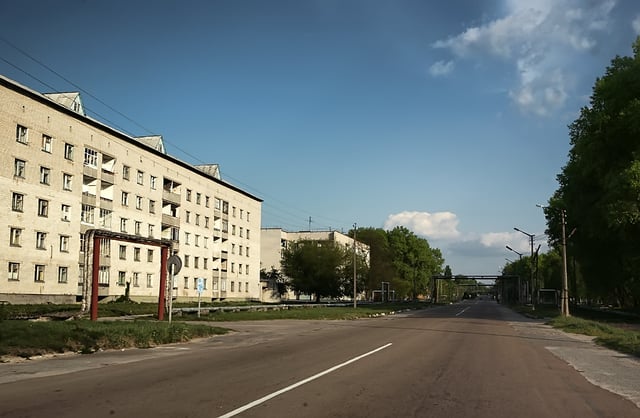
Abandoned buildings in Chernobyl
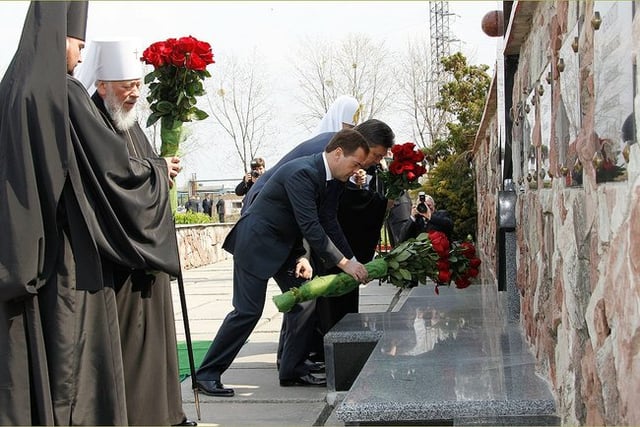
Russian president Dmitry Medvedev and Ukrainian president Viktor Yanukovych laying flowers at the memorial to the victims of the Chernobyl disaster in April 2011.
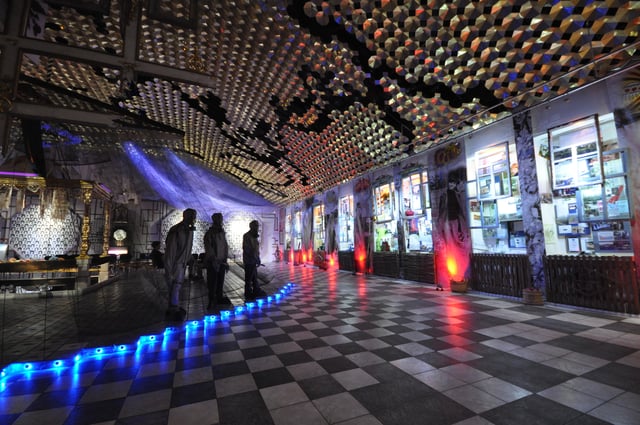
Exposition at Ukrainian National Chernobyl Museum
It is difficult to establish the total economic cost of the disaster. According to Mikhail Gorbachev, the Soviet Union spent 18 billion rubles (the equivalent of US$18 billion at that time, or $35.7 billion in today's dollars[238]) on containment and decontamination, virtually bankrupting itself.[25] In 2005, the total cost over 30 years for Belarus alone was estimated at US$235 billion;[171] about $297 billion in today's dollars given inflation rates.[238]
Ongoing costs are well known; in their 2003–2005 report, The Chernobyl Forum stated that between five and seven percent of government spending in Ukraine is still related to Chernobyl, while in Belarus more than $13 billion is thought to have been spent between 1991 and 2003, with 22% of national budget having been Chernobyl-related in 1991, falling to six percent by 2002.[171] In 2018, Ukraine spent five to seven percent of its national budget on recovery activities related to the Chernobyl disaster.[239] Overall economic loss is estimated at $235 billion in Belarus.[239] Much of the current cost relates to the payment of Chernobyl-related social benefits to some seven million people across the three countries.[171]
A significant economic impact at the time was the removal of 784,320 ha (1,938,100 acres) of agricultural land and 694,200 ha (1,715,000 acres) of forest from production. While much of this has been returned to use, agricultural production costs have risen due to the need for special cultivation techniques, fertilizers and additives.[171] Politically, the accident gave great significance to the new Soviet policy of glasnost,[240][241] and helped forge closer Soviet–US relations at the end of the Cold War, through bioscientific cooperation.[108] [] The disaster also became a key factor in the dissolution of the Soviet Union in 1991, and a major influence in shaping the new Eastern Europe.[108] []
Trial
A trial took place from 7 to 30 July 1987 in a makeshift courtroom setup in the House of Culture in Chernobyl, Ukraine. Five plant employees (the former deputy chief engineer Anatoly S. Dyatlov, the former plant director, Viktor P. Bryukhanov; the former chief engineer, Nikolai M. Fomin; the shift director of Reactor 4, Boris V. Rogozhin, and the chief of Reactor 4, Aleksandr P. Kovalenko) and Gosatomenergonadzor (USSR State Committee on Supervision of Safe Conduct of Work in Atomic Energy) inspector Yuri A. Laushkin were sentenced to 10, 10, 10, 5, 3 and 2 years respectively[243] in labor camps. The families of Aleksandr Akimov, Leonid Toptunov and Valery Perevozchenko had received official letters but prosecution against the employees had been terminated at their deaths.
Aftermath
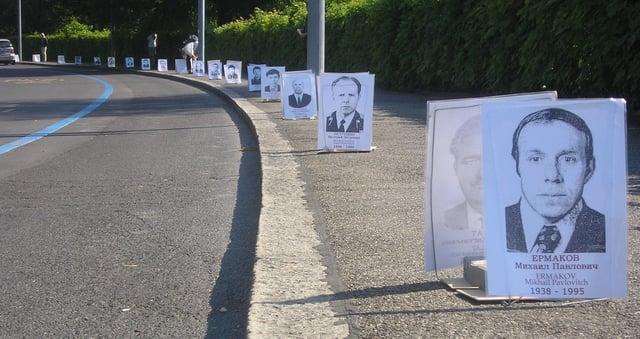
Portraits of deceased Chernobyl liquidators used for an anti-nuclear power protest in Geneva
Following the accident, questions arose about the future of the plant and its eventual fate. All work on the unfinished reactors No. 5 and No. 6 was halted three years later. However, the trouble at the Chernobyl plant did not end with the disaster in reactor No. 4. The damaged reactor was sealed off and 200 cubic meters (260 cu yd) of concrete was placed between the disaster site and the operational buildings. The work was managed by Grigoriy Mihaylovich Naginskiy, the deputy chief engineer of Installation and Construction Directorate – 90. The Ukrainian government allowed the three remaining reactors to continue operating because of an energy shortage in the country.
Decommissioning
In October 1991, a fire broke out in the turbine building of reactor No. 2;[244] the authorities subsequently declared the reactor damaged beyond repair, and it was taken offline. Reactor No. 1 was decommissioned in November 1996 as part of a deal between the Ukrainian government and international organizations such as the IAEA to end operations at the plant. On 15 December 2000, then-President Leonid Kuchma personally turned off reactor No. 3 in an official ceremony, shutting down the entire site.[245]
Confinement
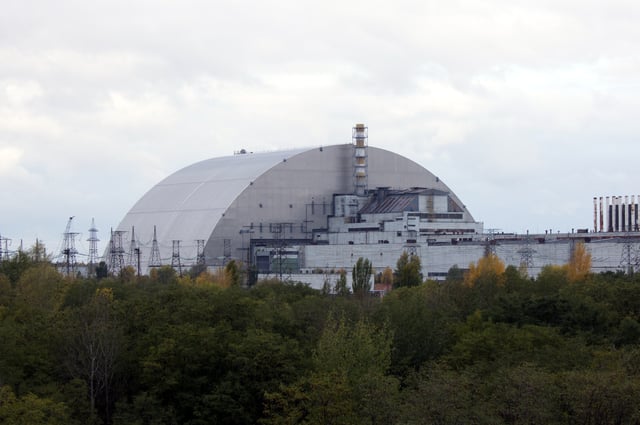
New Safe Confinement in 2017
Soon after the accident, the reactor building was quickly encased by a mammoth concrete sarcophagus in a notable feat of construction under severe conditions. Crane operators worked blindly from inside lead-lined cabins taking instructions from distant radio observers, while gargantuan-sized pieces of concrete were moved to the site on custom-made vehicles. The purpose of the sarcophagus was to stop any further release of radioactive particles into the atmosphere, mitigate damage should the core go critical and explode, and provide safety for the continued operations of adjacent reactors one through three.[14]
The concrete sarcophagus was never intended to last very long, with a lifespan of only 30 years. On 12 February 2013, a 600 m2 (6,500 sq ft) section of the roof of the turbine-building collapsed, adjacent to the sarcophagus, causing a new release of radioactivity and temporary evacuation of the area. At first it was assumed that the roof collapsed because of the weight of snow, however the amount of snow was not exceptional, and the report of a Ukrainian fact-finding panel concluded that the collapse was the result of sloppy repair work and aging of the structure. Experts warned the sarcophagus itself was on the verge of collapse.[246][247]
In 1997, the international Chernobyl Shelter Fund was founded to design and build a more permanent cover for the unstable and short-lived sarcophagus. It received more than €810 million and was managed by the European Bank for Reconstruction and Development (EBRD). The new shelter was named the New Safe Confinement and construction began in 2010. It is a metal arch 105 metres (344 ft) high and spanning 257 metres (843 ft) built on rails adjacent to the reactor No. 4 building so that it could be slid over top the existing sarcophagus. The New Safe Confinement was completed in 2016 and slid into place over top the sarcophagus on 29 November.[248] The huge steel arch was moved into place over several weeks.[249] Unlike the original sarcophagus, the New Safe Confinement is designed to allow the reactor to be safely dismantled using remotely operated equipment.
Waste management
Used fuel from units 1–3 was stored in the units' cooling ponds, and in an interim spent fuel storage facility pond, ISF-1, which now holds most of the spent fuel from units 1–3, allowing those reactors to be decommissioned under less restrictive conditions. Approximately 50 of the fuel assemblies from units 1 and 2 were damaged and required special handling. Moving fuel to ISF-1 was thus carried out in three stages: fuel from unit 3 was moved first, then all undamaged fuel from units 1 and 2, and finally the damaged fuel from units 1 and 2. Fuel transfers to ISF-1 were completed in June 2016.[250]
A need for larger, longer-term radioactive waste management at the Chernobyl site is to be fulfilled by a new facility designated ISF-2. This facility is to serve as dry storage for used fuel assemblies from units 1–3 and other operational wastes, as well as material from decommissioning units 1–3 (which will be the first RBMK units decommissioned anywhere).
A contract was signed in 1999 with Areva NP (now Framatome) for construction of ISF-2. In 2003, after a significant part of the storage structures had been built, technical deficiencies in the design concept became apparent. In 2007, Areva withdrew and Holtec International was contracted for a new design and construction of ISF-2. The new design was approved in 2010, work started in 2011, and construction was completed in August 2017.[251]
ISF-2 is the world's largest nuclear fuel storage facility, expected to hold more than 21,000 fuel assemblies for at least 100 years. The project includes a processing facility able to cut the RBMK fuel assemblies and to place the material in canisters, to be filled with inert gas and welded shut. The canisters are then to be transported to dry storage vaults, where the fuel containers will be enclosed for up to 100 years. Expected processing capacity is 2,500 fuel assemblies per year.[126]
Fuel-containing materials
According to official estimates, about 95% of the fuel in reactor No. 4 at the time of the accident (about 180 metric tons (180 long tons; 200 short tons)) remains inside the shelter, with a total radioactivity of nearly 18 million curies (670 PBq). The radioactive material consists of core fragments, dust, and lava-like "fuel containing materials" (FCM)—also called "corium"—that flowed through the wrecked reactor building before hardening into a ceramic form.
Three different lavas are present in the basement of the reactor building: black, brown, and a porous ceramic. The lava materials are silicate glasses with inclusions of other materials within them. The porous lava is brown lava that dropped into water and thus cooled rapidly. It is unclear how long the ceramic form will retard the release of radioactivity. From 1997 to 2002, a series of published papers suggested that the self-irradiation of the lava would convert all 1,200 metric tons (1,200 long tons; 1,300 short tons) into a submicrometre and mobile powder within a few weeks.[252]
It has been reported that the degradation of the lava is likely to be a slow, gradual process, rather than sudden and rapid.[253] The same paper states that the loss of uranium from the wrecked reactor is only 10 kg (22 lb) per year; this low rate of uranium leaching suggests that the lava is resisting its environment.[253] The paper also states that when the shelter is improved, the leaching rate of the lava will decrease.[253]
Exclusion zone
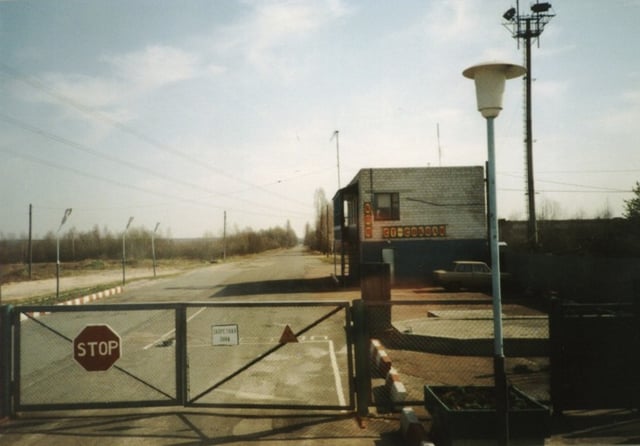
Entrance to the zone of alienation around Chernobyl
An area originally extending 30 kilometres (19 mi) in all directions from the plant is officially called the "zone of alienation." It is largely uninhabited, except for about 300 residents who have refused to leave. The area has largely reverted to forest, and has been overrun by wildlife because of a lack of competition with humans for space and resources. Even today, radiation levels are so high that the workers responsible for rebuilding the sarcophagus are only allowed to work five hours a day for one month before taking 15 days of rest. As of 2016, 187 locals had returned and were living permanently in the zone.[254]
In 2011 Ukraine opened up the sealed zone around the Chernobyl reactor to tourists who wish to learn more about the tragedy that occurred in 1986.[255][256][257] Sergii Mirnyi, a radiation reconnaissance officer at the time of the accident, and now an academic at National University of Kyiv-Mohyla Academy, has written about the psychological and physical effects on survivors and visitors, and worked as an advisor to Chernobyl tourism groups.[257][258]
Forest fire concerns
During the dry seasons, a perennial concern is forests that have been contaminated by radioactive material catching on fire. The dry conditions and build-up of debris make the forests a ripe breeding ground for wildfires.[259] Depending on the prevailing atmospheric conditions, the fires could potentially spread the radioactive material further outwards from the exclusion zone in the smoke.[260][261] In Belarus, the Bellesrad organization is tasked with overseeing the food cultivation and forestry management in the area.
Recovery projects
The Chernobyl Trust Fund was created in 1991 by the United Nations to help victims of the Chernobyl accident.[262] It is administered by the United Nations Office for the Coordination of Humanitarian Affairs, which also manages strategy formulation, resources mobilization, and advocacy efforts.[263] Beginning 2002, under the United Nations Development Programme, the fund shifted its focus from emergency assistance to long-term development.[239][263]
The Chernobyl Shelter Fund was established in 1997 at the Denver 23rd G8 summit to finance the Shelter Implementation Plan (SIP). The plan calls for transforming the site into an ecologically safe condition by means of stabilization of the sarcophagus followed by construction of a New Safe Confinement (NSC). While the original cost estimate for the SIP was US$768 million, the 2006 estimate was $1.2 billion. The SIP is being managed by a consortium of Bechtel, Battelle, and Électricité de France, and conceptual design for the NSC consists of a movable arch, constructed away from the shelter to avoid high radiation, to be slid over the sarcophagus. The NSC was moved into position in November 2016 and is expected to be completed in late-2017.[264]
In 2003, the United Nations Development Programme launched the Chernobyl Recovery and Development Programme (CRDP) for the recovery of the affected areas.[265] The programme was initiated in February 2002 based on the recommendations in the report on Human Consequences of the Chernobyl Nuclear Accident. The main goal of the CRDP's activities is supporting the Government of Ukraine in mitigating long-term social, economic, and ecological consequences of the Chernobyl catastrophe. CRDP works in the four most Chernobyl-affected areas in Ukraine: Kyivska, Zhytomyrska, Chernihivska and Rivnenska.
More than 18,000 Ukrainian children affected by the disaster have been treated at Cuba's Tarará resort town since 1990.[266]
The International Project on the Health Effects of the Chernobyl Accident was created and received US$20 million, mainly from Japan, in hopes of discovering the main cause of health problems due to 131I radiation. These funds were divided among Ukraine, Belarus, and Russia, the three main affected countries, for further investigation of health effects. As there was significant corruption in former Soviet countries, most of the foreign aid was given to Russia, and no positive outcome from this money has been demonstrated.
Nuclear debate
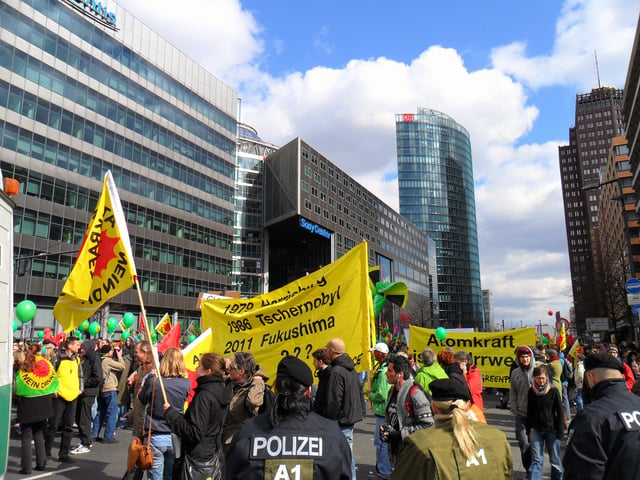
Nuclear power protest in Berlin, 2011
The Chernobyl accident attracted a great deal of interest. Because of the distrust that many people had in the Soviet authorities, a great deal of debate about the situation at the site occurred in the First World during the early days of the event. Because of defective intelligence based on satellite imagery, it was thought that unit number three had also suffered a dire accident. Journalists mistrusted many professionals, and they in turn encouraged the public to mistrust them.[190] The accident raised the already heightened concerns about fission reactors worldwide, and while most concern was focused on those of the same unusual design, hundreds of disparate nuclear reactor proposals, including those under construction at Chernobyl, reactors numbers 5 and 6, were eventually cancelled. With ballooning costs as a result of new nuclear reactor safety system standards and the legal and political costs in dealing with the increasingly hostile/anxious public opinion, there was a precipitous drop in the rate of new startups after 1986.[267]
The accident also raised concerns about the cavalier safety culture in the Soviet nuclear power industry, slowing industry growth and forcing the Soviet government to become less secretive about its procedures.[268][5] The government coverup of the Chernobyl disaster was a catalyst for glasnost, which "paved the way for reforms leading to the Soviet collapse."[269] Numerous structural and construction quality issues as well as deviations from the original design of the plant were known to KGB at least since 1973 and passed to the Central Committee which did not take any actions and classified it.[270]
In Italy, the Chernobyl accident was reflected in the outcome of the 1987 referendum. As a result of that referendum, Italy began phasing out its nuclear power plants in 1988, a decision that was effectively reversed in 2008. A 2011 referendum reiterated Italians' strong objections to nuclear power, thus abrogating the government's decision of 2008.
In Germany, the Chernobyl accident led to the creation of a federal environment ministry, after several states had already created such a post. The minister was given the authority over reactor safety as well, which the current minister still holds as of 2019. The events are also credited with strengthening the anti-nuclear movement in Germany, which culminated in the decision to end the use of nuclear power that was made by the 1998–2005 Schröder government.[271]
In direct response to the Chernobyl disaster, a conference to create a Convention on Early Notification of a Nuclear Accident was called in 1986 by the International Atomic Energy Agency. The resulting treaty has bound signatory member states to provide notification of any nuclear and radiation accidents that occur within its jurisdiction that could affect other states, along with the Convention on Assistance in the Case of a Nuclear Accident or Radiological Emergency.
The Chernobyl, along with the space shuttle Challenger disaster, the Three Mile Island accident, and the Bhopal disaster have been used together as case studies, both by the US government and by third parties, in research concerning the root causes of such disasters, such as sleep deprivation[272] and mismanagement.[273]
See also
Cultural impact of the Chernobyl disaster
List of Chernobyl-related articles
List of industrial disasters
Lists of nuclear disasters and radioactive incidents
Nuclear and radiation accidents and incidents
Nuclear fallout effects on an ecosystem


